








Welcome to the latest round up of news from the Worshipful Company of Needlemakers.
This newsletter follows our splendid Banquet at the Mansion House and includes a message from Master Dr Sue Sumners.
We reflect on Past Master Graham Born (2003) who passed away in January, and there are many more pieces on the Livery, its history, and its extended involvement in London and the City.
Many thanks to all without whom the production of this newsletter would be impossible, particularly the contributors and those behind the scenes including Freeman Yasmin BakerMarshall and the Clerk.
March2025
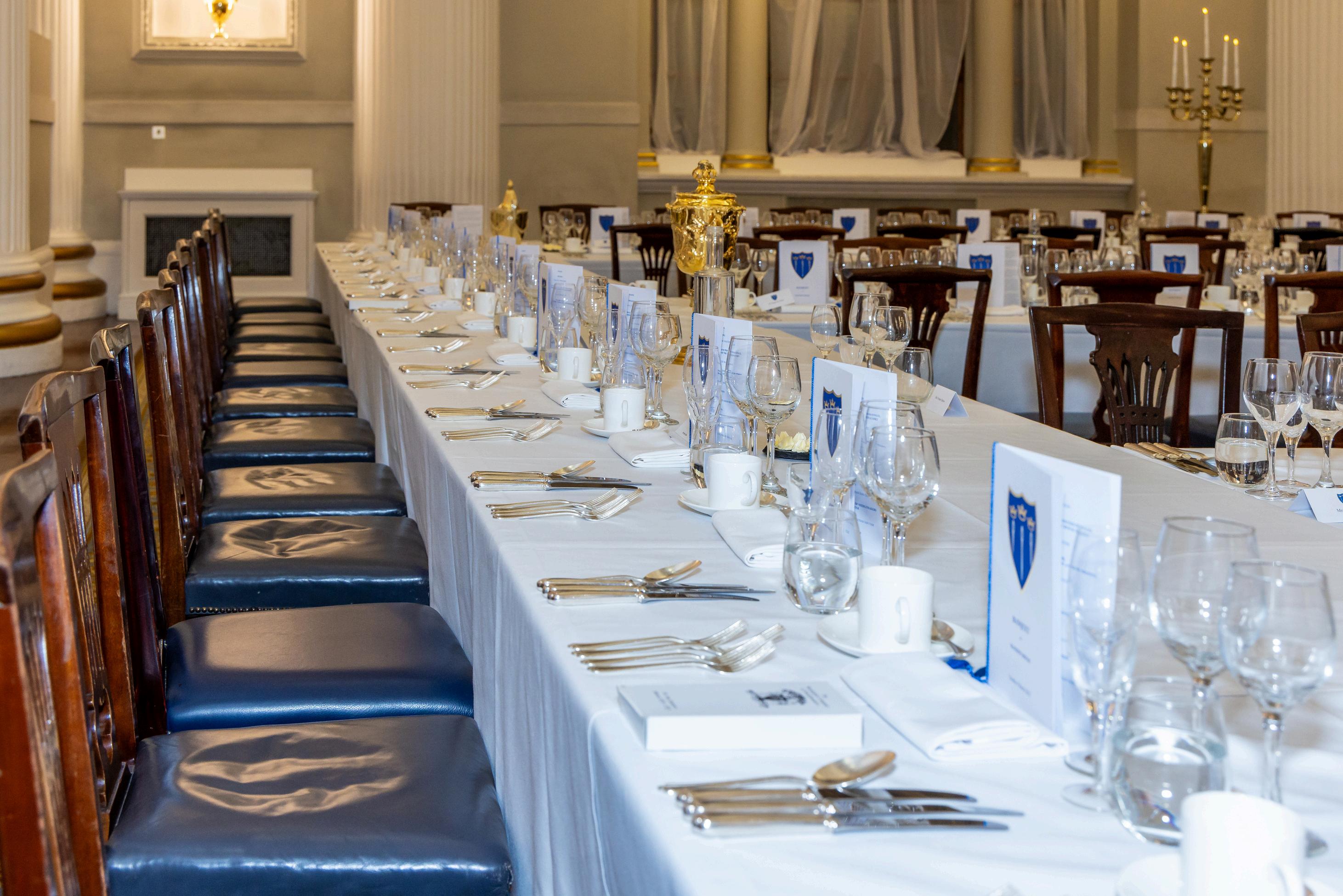
Several months into her year as Master, SUE SUMNERS hopes that all those who were there enjoyed the Banquet at Mansion House (we did! Ed.) and considers someofthehighlightsofhertenuresofar.

I am sure I am not the first Master to reflect on how quickly time is moving on. One third of the year has already passed.
It has been – and continues to be – a privilege to be able to represent our Company at so many events. I have been honoured to have been invited to attend Installation Services and dinners with other Companies and note how we all do events in different ways.
I went to Treloar’s School with the Lord Mayor and other Masters to see the education provided to severely disabled students.
The launch of our Advanced Needle Technology Award Needlemakers Award at the Worshipful Company of Entrepreneurs’ “EASI” showcase at Drapers’ Hall was an exciting evening, especially as it was the first event held by the Entrepreneurs after they had been granted Livery status as the 112th Livery Company. I am proud to be able to share with other Companies the details of this award, and by the time of the next newsletter we should have received the first applications from candidates As a Company, we are proud of our charitable work, and this is another way of providing support.
We had our first lunch of 2025 at Cutlers’ Hall, and I am sure we all left knowing a little more about bells than


when we arrived. I was impressed by the creative display from Fine Cell, another charity that we sponsor.
There have been other events organised within the Company. David and I enjoyed our lunch at Watermen’s Hall with fellow Liverymen on Valentine’s Day. And I was just about getting used to being called Master until the cheese tasting at Paxton & Whitfield, when I suddenly became “The Big Cheese”!
Of course, with needles being our craft, I had once again to up my game to produce my own needle cushion under the expert tuition of Elizabeth Whitton. And though I say it myself, I was delighted with my handiwork! I was equally delighted that I didn’t disgrace myself or the Company in the Annual Pancake Race, held in the
glorious sunshine in Guildhall Yard on Shrove Tuesday.
Most recently, and later that day, was the Banquet at Mansion House. What a tremendous event, and my thanks to all those who made it possible.
All these events have been such a pleasure, and it makes me realise how fortunate I am to be Master of the Needlemakers.
Engagement is my theme for the year, so I hope to see and engage with you all, from our newest to our longest-serving members, perhaps at one of our events that you have not previously enjoyed.
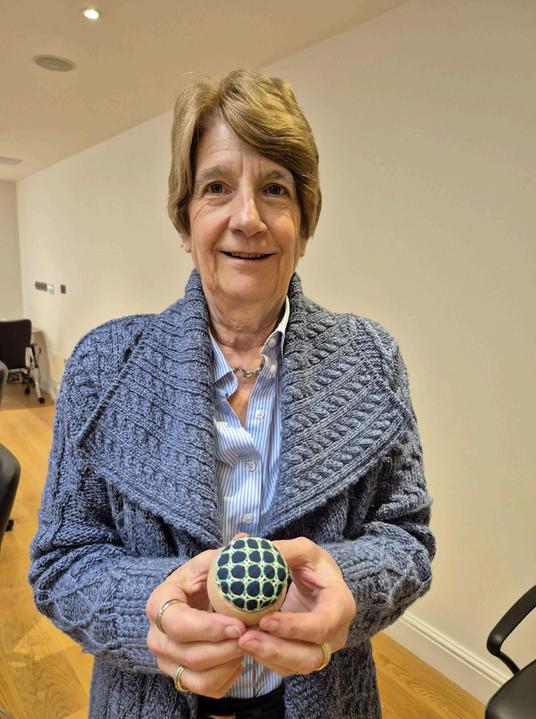

And what a night it was! Freeman ROXINE STAATS reflects on her first MansionHouseBanquet–butshehopesnotthelast…
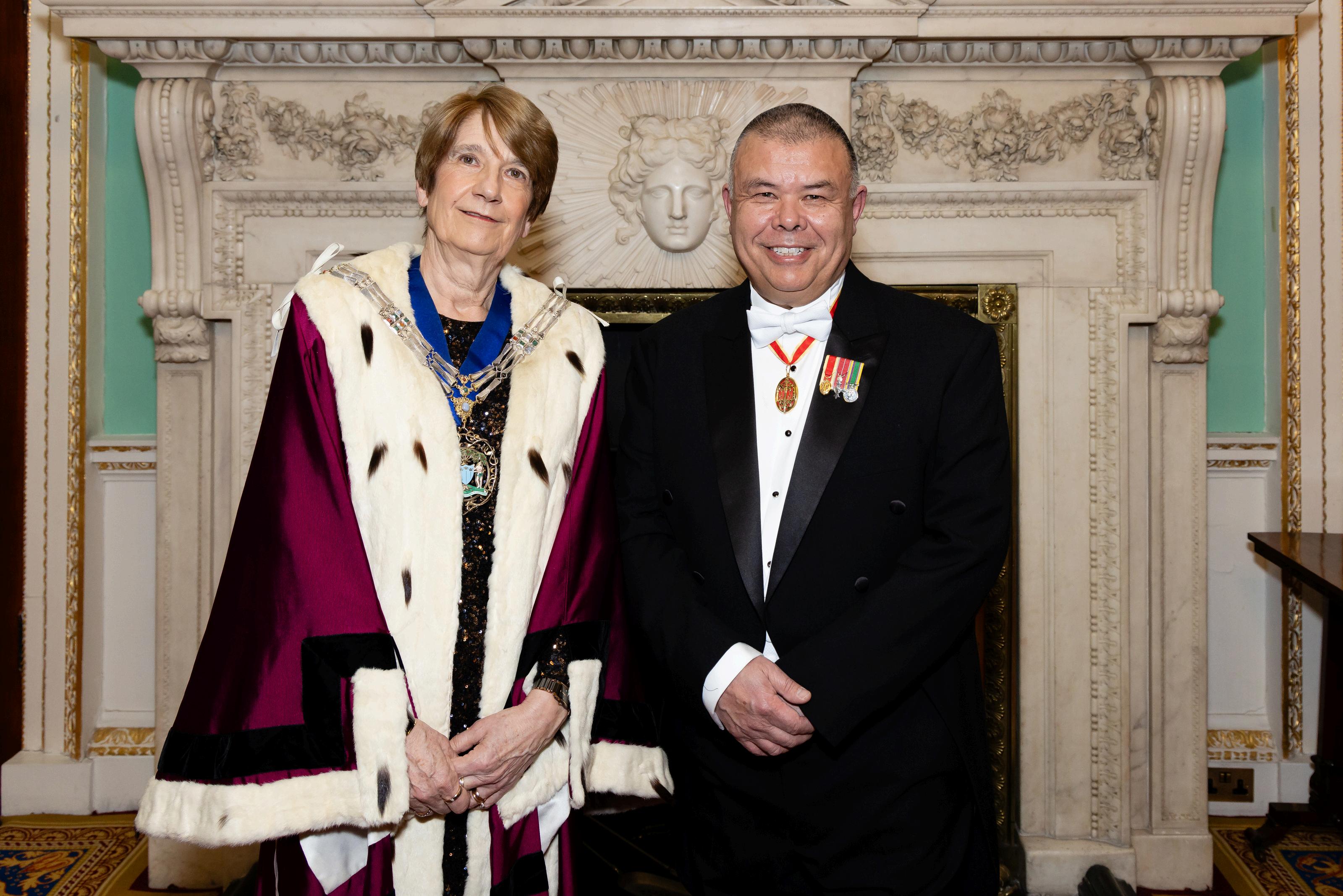
AS DUSK settled on a sunny March day, we made our way to the Mansion House for the
pleasure of joining the Worshipful Company of Needlemakers’ annual Mansion House Banquet. As a freshly minted Freeman of the Company, this would not only be my first Mansion House Banquet, but my first event in the presence of the Lord Mayor and Lady Mayoress. As I crossed the threshold and was greeted by familiar beaming smiles, the convivial buzz of pre-prandial chatter and a string quartet, it became clear that this evening would epitomise the sense of occasion, togetherness and fellowship that first drew me to the Company and its members.
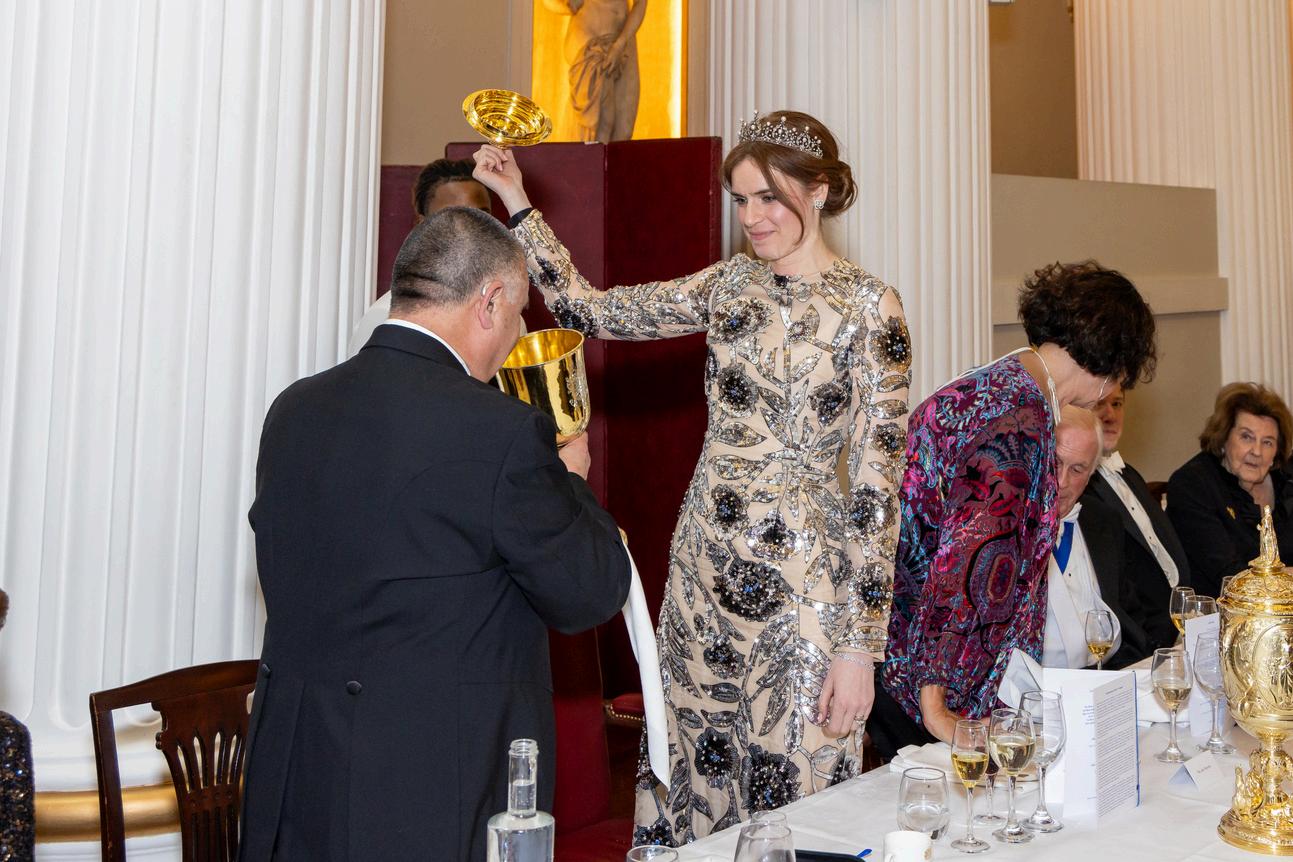
Having been delightfully greeted by the Master, Wardens and their spouses, my guest and I (with place cards and champagne in hand) joined the other diners in pre-dinner conversation, and explored the impressive collection of Dutch masterpieces arranged over the various beautifully appointed drawing rooms.
May I thank the cadets from our affiliated 27F (Chingford) Air Training Squadron for such a smart turnout during the reception.
The trumpets sounded to usher in the Lord Mayor and Lady Mayoress. The Lady Mayoress was particularly resplendent in a gown of intricate silver sequin work, chosen I understand as a thoughtful nod to the Company’s historic trade.
With this, all the guests moved to take their seats in the magnificent Egyptian Hall to await the entrance of the Master, Wardens and the rest of the guests in the top table procession. Rows of gargantuan white columns loomed overhead as the expansive room filled with excited chatter, complemented by the string ensemble who played from the gallery above.
As much as the illustrious surrounds and the strings’ repertoire of Bach and Bizet were a feast for the eyes and ears, so was the thoughtfully curated menu a culinary delight. Service commenced and we processed through four courses: sea bass ceviche, guinea fowl supreme, Stilton crumble and Basque cheesecake, each accompanied by a delectable wine pairing. We also celebrated 1000 years of history with the Loving Cup, another new
experience for me, and enjoyed the rather splendid post horn gallop.
The glorious setting and festivities were made all the more memorable by the roster of distinguished guests and speakers. Most notably, Professor Sir Jonathan Van-Tam gave a moving account of his early life and career culminating in his integral role in the UK’s response to the COVID-19 pandemic as England’s Deputy Chief Medical Officer. The Egyptian Hall was transfixed as he recounted the momentous evening, during the height of the pandemic in 2020, that he and a colleague first learned of the positive outcome of the testing of a vaccine, and their rapturous reaction to the know ledge that humanity now had a tool with which to combat the disease – and the foresight to pre-order 200 million
needles to deliver it. This was a fitting reminder, too, of the charitable and industrial mission of the Company, as it strives to drive investment and innovation in the biomedical sciences and human health.
We heard also from the Master, the Lord Mayor, and the Junior Warden, Simon Bentley, who welcomed some of the other honoured guests, including Mike Harris, Master of the Worshipful Company of Spectacle Makers, and his wife Carole; Lars Andersen, Master of the Worshipful Company of World Traders, and his wife Jenifer; Adrian Waddingham, Master of the Guild of Freemen of the City of London, and his wife Angela; and Lt Col Nathan Horsman, CO of the Third Battalion Princess of Wales’s Royal Regiment, and his wife Vera

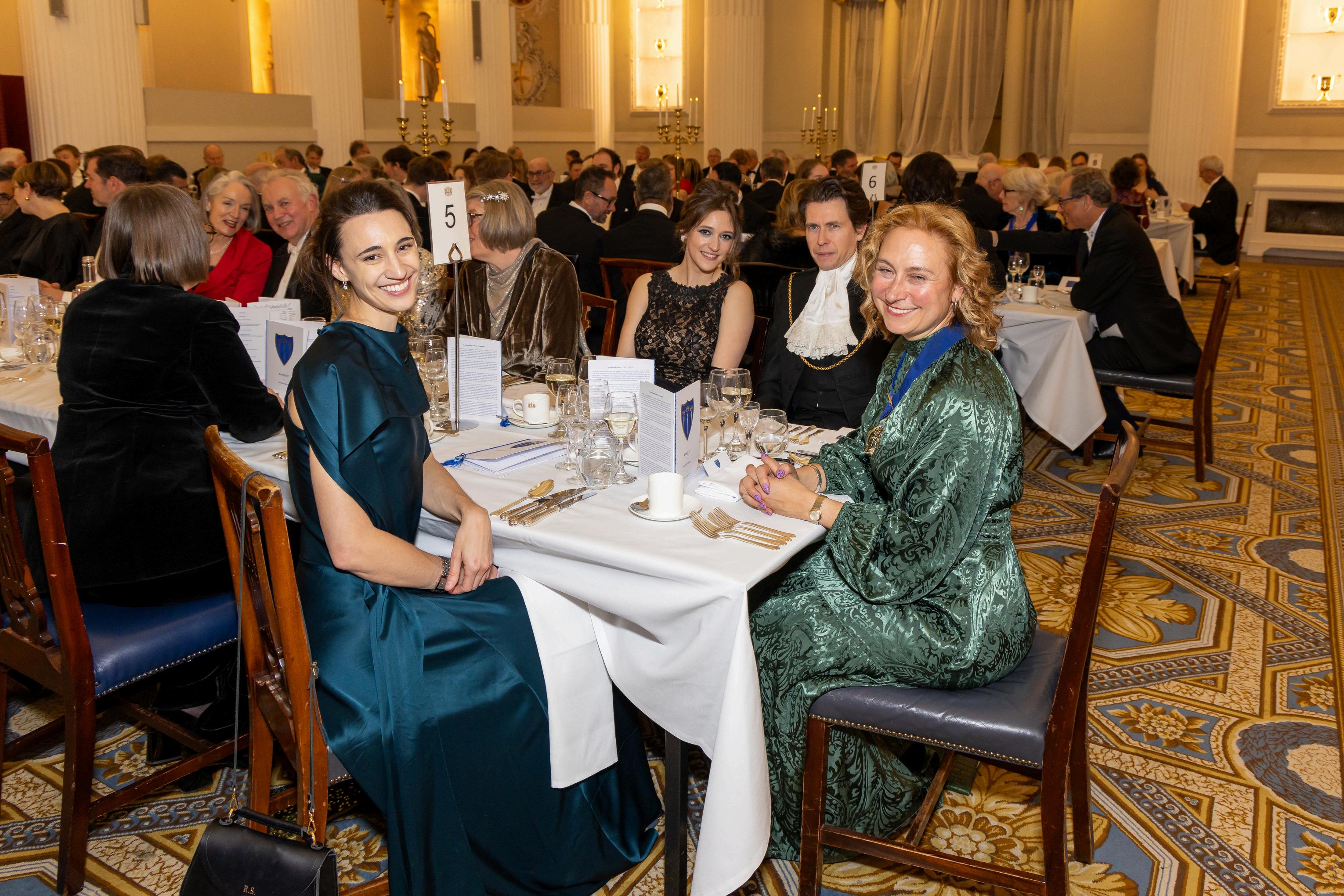
My own guest and I had the additional pleasure of being seated near not only the Clerk, but also the City of London's Swordbearer, Tim Rolph, who was a splendid dining companion and font of knowledge, happily sharing with us the ins and outs of everyday life in the Square Mile. The rich history and significance of our awe-inspiring surroundings were cemented even more profoundly to us as we listened keenly to his accounts of ceremonial processions and receiving the King as
a dinner guest.
It’s no wonder that the Mansion House Banquet is regarded as the splendid jewel in the crown of the Company’s events calendar. I was delighted by the occasion, the setting and by the splendid company, both in new meetings and in having the pleasure of sharing this memorable evening with friends at the Company, and, just a few days later, I am already keenly awaiting the next one (and all those to follow!).
The funeral service for Past Master Graham Born (2003), who died on 6th January, was held in Essex on 3rd February 2025, and was well attended by family, friends and of course Needlemakers. Hon. Almoner GILL LOFTUS was oneofthem.
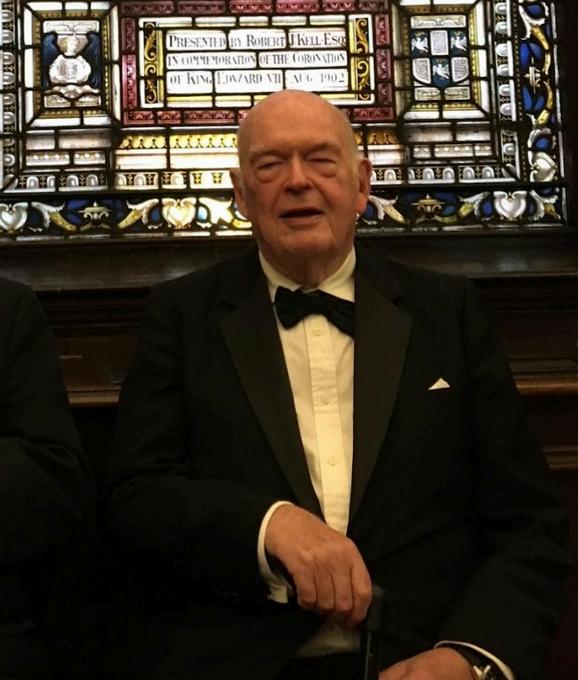
THE DELIGHTFUL service at the lovely old church of St Mary the Virgin in Shenfield was
conducted by the Rector, Reverend Canon Darren Barlow. A large number of Needlemakers attended, together with “Old Brentwoods” and members of Thorndon Park Golf Club, and we were treated to an excellent family eulogy, beautifully read by his son Simon, a Liveryman of the Company, which captured the essence of Graham’s spirit and humour.
It was particularly pleasing to Graham’s widow Shirley, and to us, that our Chaplain, Bishop Christopher
Chessun, was able to take part in the service, and that he added his own fitting tribute to Graham. Afterwards, the Born family hosted a very convivial reception at the Ivy Hill Hotel at Ingatestone.
Graham was born on 3rd October 1940 and grew up with his parents and sister, Sally Ann, in Hanging Hill Lane, in Hutton, close to Brentwood in Essex, and attended Brentwood School. He supported his old school whenever he could and was a past President of the Old Brentwoods’ Society.
Graham was articled to the same firm of Chartered Accountants used by his father’s manufacturing company. He went on to become partner and then senior partner at Maurice J. Bushell & Company, the oldest firm of Chartered Accountants in the City of London.
Graham met Shirley, and they married in 1970 and settled in Billericay, Essex, not far from where he had grown up. The two boys, Andrew and Simon, were born there.
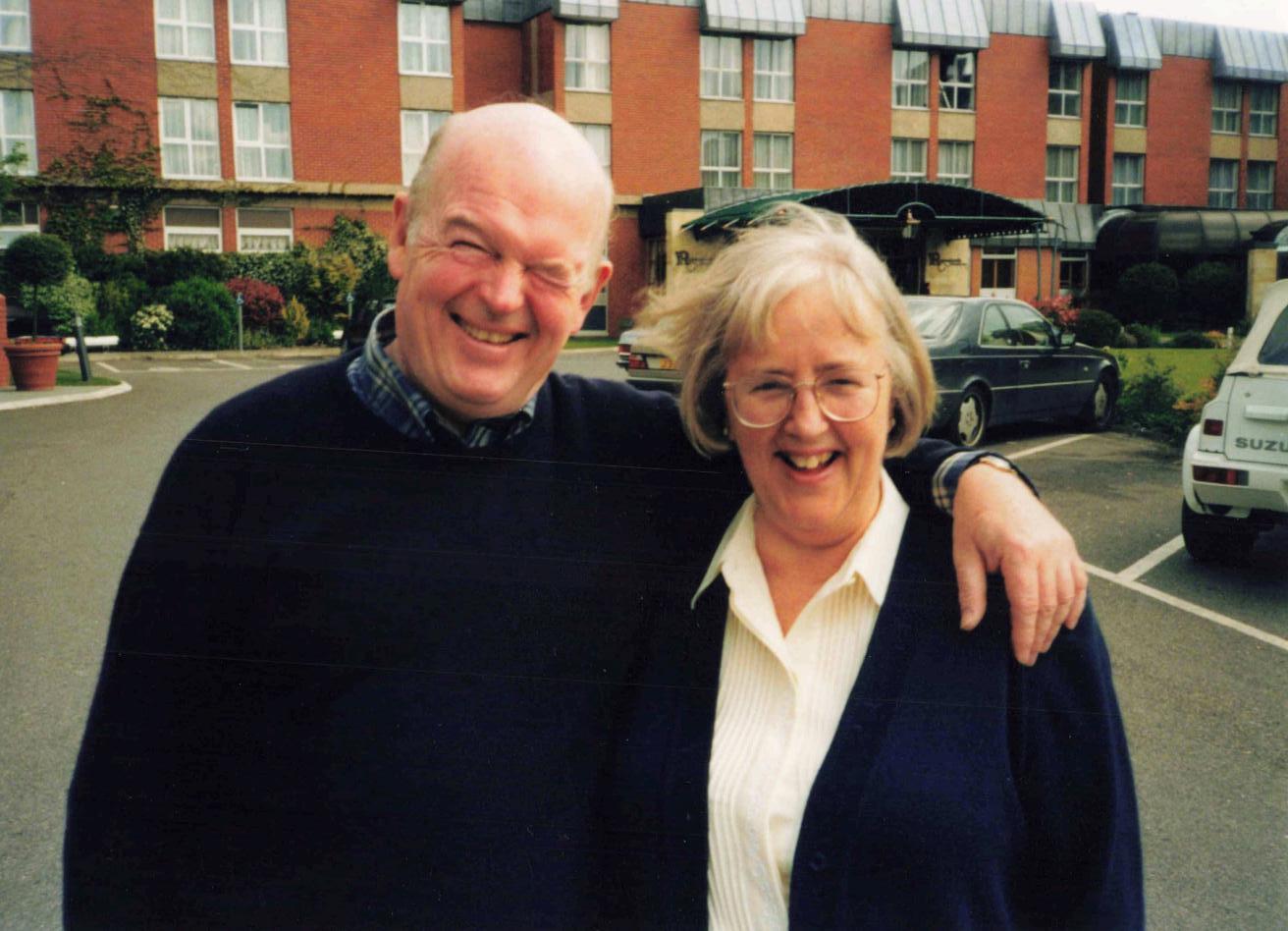
As Simon told us: In all matters sartorial, Graham cut a dash. He owned many hats, including a bowler; he wore plus-fours on the golf course, and he never wore a pair of jeans in his life. Gardening gave him an excuse to purchase a blue boiler suit, which he loved – and the sight could not have been more Churchillian!
Graham was a great patriot, enjoying Royal Ascot, the Royal Tournament at Earl’s Court, the Trooping of the Colour (great music; great hats!) and Carols from King’s at Christmas. He was a member of Thorndon Park Golf Club.
In the late 1970s and early 1980s, Graham took the family almost exclusively to the South of France for their holiday. Once or twice, after venturing to another country, Graham was asked if he’d enjoyed it, and was heard to reply “Yes, but it’s not France, is it?”. For many years, he kept a small boat there, which was used for waterskiing, picnicking and
Sea. It therefore required a precise timing and use of the throttle, to bring the nose of the boat up, enabling the boat to ride over the waves.
One day, Graham was tasked with ferrying Shirley and her former school friend (and fellow teacher) Auntie Jill, and Jill’s husband, Bob, to the nearby islands.
Both ladies started out with flowing summer dresses and perfectly coiffed hair, until Captain Graham completely misjudged the oncoming wake from a fast and heavily laden island boat. The nose went down when it should have gone up; a tsunami of seawater was flipped up from the bow into the air and dumped in equal and enormous measure on Shirley and Jill!

The sight was not a pretty one. “We’re going to need a bigger boat” is the famous line from the film, Jaws. Perhaps it was that line which prompted Graham to follow that advice, and acquire one the following year…
Graham trained for and received his private pilot’s licence, but If flying was the zenith of Graham’s vehicular achievements, then his nadir surely occurred when in the long queue of cars at the Port of Calais, waiting for the wave from the ferry staff for the cars to drive on.
Simon recalled that Shirley had popped out of the car to get some fresh air and was taking rather a long time. Suddenly the signal was given, and the other cars rushed off. What was Graham to do? Drive onto the ferry, or wait for his beloved?
Graham decided, for whatever reason, to get on the ferry. In a panic,
and having realised he had made the wrong choice, he grabbed a member of staff. “Monsieur” I have left my wife behind!” “Monsieur! Mes felicitations!” exclaimed the Frenchman, and shook him enthusiastically by the hand. A rather disgruntled Shirley found her own way onto the ferry, but all ended well with the purchase of a large bottle of eau de parfum.
Graham followed his father into masonry at an early age, and joined the Old Brentwoods’ and Needlemakers’ Lodges, being a Past Master of both.
Graham acted as governor, and then chairman of the governors, of the prestigious catholic girl’s school, New Hall, for many years, and was instrumental in negotiating the split between the religious order and the school. As a protestant, he was perhaps considered neutral by both parties.
Graham was always surprised how the headmistress, a nun, of course, in those days, “knew how to pour such a terrific gin and tonic!”
Like many Old Brentwoods back in the day, Graham was encouraged to join the Needlemakers’ Livery Company by Geoffrey Bayman, Needlemaker and benefactor of the town of Brentwood as well as the school. The Bayman family lived in a magnificent old house in Hall Lane, Shenfield, which has since become the Old Shenfield Place Care Home, where Graham was so well cared for and where he eventually passed away.
Graham was clothed as a Liveryman on 1st February 1972. He and Shirley were great supporters of the Company and its charitable ethos. They regularly attended the Banquet and came to many events. In 1993, Graham was invited onto the Court,
and he became Master in 2003. Senior Warden that year was Chris Vickers, and Junior Warden was Michael Snyder. In July 2004, Graham took great paternal pride in admitting his son Simon to the Livery.
Graham organised a very popular Master’s Holiday to the Loire Valley in May 2004, where over 50 Needlemakers joined him. They flew to Nantes and stayed in Tours for four nights, visiting various chateaux, including Angers, where they were able to see the 14th century Apocalypse Tapestry, and the magnificent river-spanning Chateau Chenonceau. They explored troglodyte caves, tasted wine and enjoyed beautiful scenery – and the weather was perfect!
Simon reminded us that Graham had had more than one serious encounter with fire.
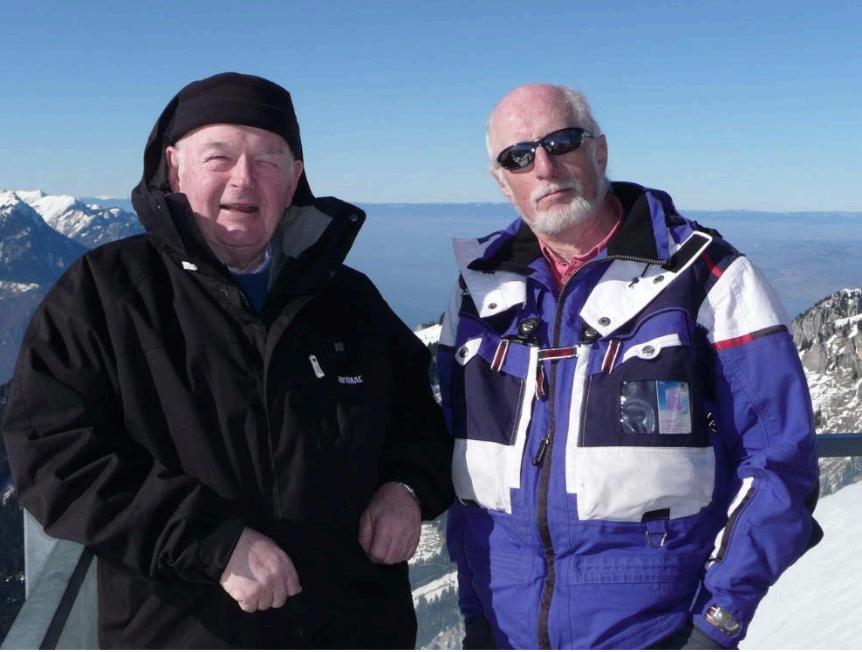
Very many years ago, Graham was in the mood for gardening and so set about clearing the leaves from the lawn. To avoid the rain and to keep the leaves dry, he decided to sweep the leaves into the garage. What to do with them? Graham took a bottle of white spirit and sprinkled it liberally over the leaves. Graham lit the white spirit. The white spirit set fire to the leaves; the leaves proceeded to set fire to the garage… In a state of panic, Graham rushed to the telephone and called the fire brigade
While waiting, Graham tried his best to control the fire. He did rather well. Rather too well, in fact. By the time the Billericay Fire Brigade arrived, the fire was out! Graham promptly invited them all in for a sherry!
Graham and Shirley’s home in South Weald suffered a fire just over six years ago. The reason is unimportant, but what was amazing was Graham. Shirley had wanted to go into the living room to rescue her handbag. By that time, the living room was already ablaze, and the handbag long gone. Graham took Shirley’s hand, turned to her and simply said “Shirley it’s time

Simon concluded by saying that, in the very many kind messages conveyed to Shirley, there is one recurring theme – namely, considering Graham to have beenagentleman.NofinercomplimentcanbepaidtoanEnglishman.
Pestilence, isolation, lockdown, empty streets and statistics – 17th century London had them all. As Professor Sir Jonathan Van-Tam was our guest speaker at the Banquet in March, Liveryman KIMBALL BAILEY rummaged through Pepys’s treasure trove of daily diary entries for 1665 to find the City chronicler’srecordofLondonintheyearoftheGreatPlague.
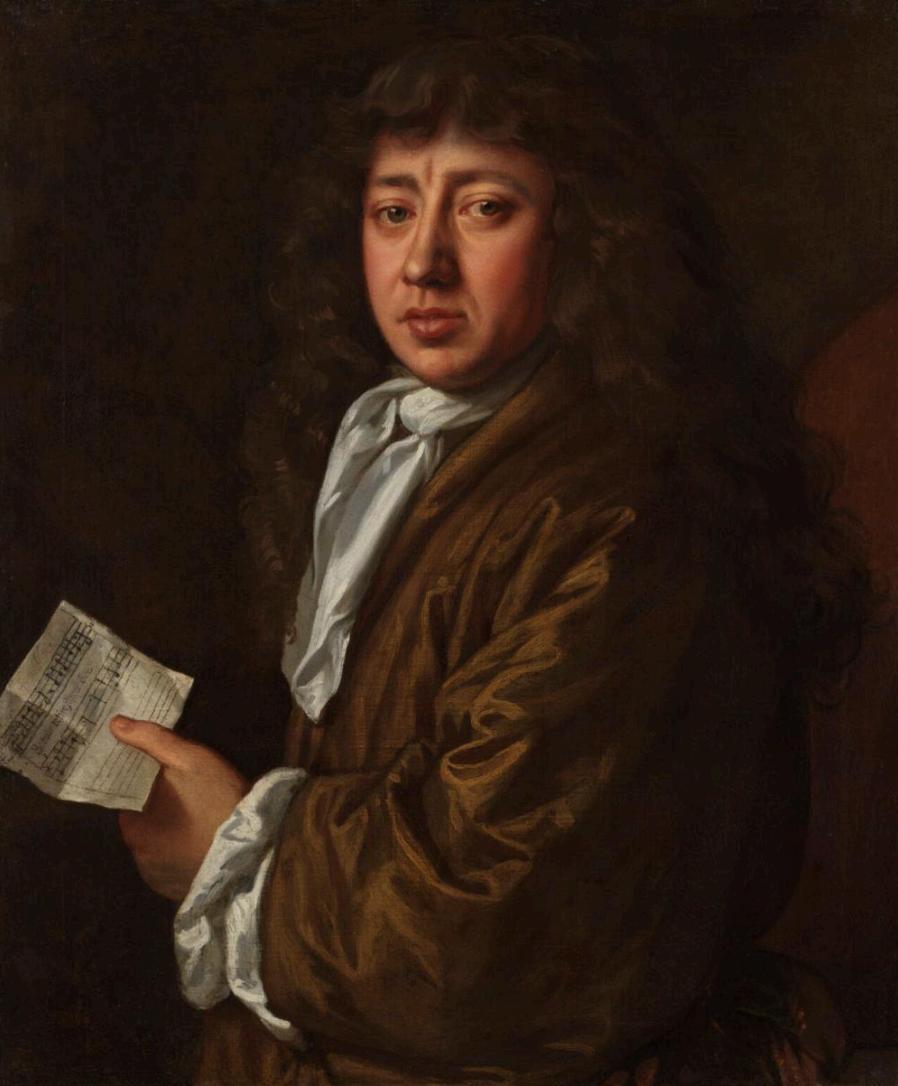
THE LIFE of Samuel Pepys, Citizen and Clothworker (as it would have said on his
Freedom certificate), is inextricably linked with the City of London. Born in 1633 in Salisbury Square off Fleet Street, the son of a tailor, he lived in Seething Lane; he commuted up and downstream to Whitehall, Woolwich and Greenwich; he watched London burn in 1666 from All Hallows by the Tower; he was imprisoned for treason (on suspicion of involvement in the Jacobite-led “Popish Plot”) in the Tower itself; he went to church in St Olave’s in Hart Street and, after his death in 1703, was buried there, near his wife Elizabeth.
Pepys was a bright scholarship boy, studying at St Paul’s and Cambridge. As a highly competent administrator and civil servant, he rose to become Chief Secretary to the Admiralty (initially under the patronage of Sir Edward Montagu, later the Earl of Sandwich). He hobnobbed with royalty and the great and good of the City and government of the time, built a small fortune, and became MP for Castle Rising in Norfolk, as well as President of the Royal Society and Master of Trinity House.
His now-famous diaries – covering 1660 to 1669 – were hardly noticed until the 19th century, stacked at the back of a bookcase in his library archive, left to Magdalene, his old Cambridge college. Written in shorthand, their beautifully observed content ranges from the touching to the salacious, a jumble of the lives of the rich and famous to those of the humblest members of the population
to the salacious, a jumble of the lives of the rich and famous to those of the humblest members of the population, from national crises to the mundane and trivial.
Pepys’s real skill is to write in such detail about people, at every level, and to express his absolute joy in life. He writes on the restoration and coronation of King Charles II (he was on the very ship that brought the King back to England), the naval war with the Dutch, and the Great Fire in 1666; more personally, he has an operation to remove a bladder stone, meets Nell Gwyn, has various affairs and sees Twelfth Night (“acted well, though it be but a silly play”).
They are well worth a read (there is an excellent edited version) and I highly recommend the reading by Kenneth Branagh – a pleasure to play in full when I was researching this article.
Let us look at that fragment of Pepys’s diaries which refers to the Great Plague of 1665-1666 – a resurgence of the bubonic plague in which 100,000 people in London died, one in four of the estimated population.
Pepys’s first mention of it was on 30 April 1665: “Great fears of the sicknesse here in the City, it being said that two or three houses are already shut up. God preserve us all.” The ongoing entries in his diaries show that – in terms of our recent
experience with the pandemic at least – there is nothing new under the sun, with lockdown, daily government statistics, self-isolation and social distancing as relevant then as in 2021. Though even Sir Chris Whitty and Sir Patrick Vallance might have baulked at the Great Fire of London as a solution to ridding the City of its infestation.
Death came quickly to London and, like the news from the BBC, was ghoulishly documented
7 June: “This day, much against my will, I did in Drury Lane see two or three houses marked with a red cross upon the doors, and ‘Lord have mercy upon us’ writ there, which was a sad sight to me, being the first of that kind to my remembrance I ever saw ”
10 June: “To my great trouble I hear that the plague is come into the City, but where should it begin but in my good friend and neighbour’s, Dr Burnett in Fenchurch Street – which in both points troubles me mightily. My ead filled with other business, particularly how to put my estate in order, in case it should please God to call me away.”
shut. But he hath, I hear, gained great goodwill among his neighbours; for he discovered it himself first, and caused himself to be shut up of his own accord –which was very handsome.”
15 June: “The town grows very sickly, and people be afeared of it, there dying this last week of the plague 112, from 43 the week before, whereof one in Fenchurch Street and one in Broad Street.”
17 June: “Going with a hackneycoach from my Lord Treasurer’s down Holborne, the coachman at last stood still, and came down hardly able to stand; and told me that he was suddenly stroke very sick and almost blind. So I light and went into another coach, with a sad heart for the poor man and trouble for myself, lest he should have been stroke with the plague. But God have mercy upon us all.”
11 June: “I out of doors and, in going, saw poor Dr Burnett’s door
8 August: “The streets mighty empty all the way now, which is a sad sight. And to Westminster Hall, where talk is of poor Will that used to sell us ale at the Hall door, his wife and three children dead, all I think in a day. So home through the City again, wishing I may have
taken no ill in going. But I will go, I think, no more thither.”
12 August: “The people die so that now it seems they are fain to carry the dead to be buried by daylight, the nights not sufficing to do it in. And my Lord Mayor commands people to be within at nine at night, that the sick may have liberty to go abroad for air.”
16 August: “Thence to the Exchange, which I have not been a great while. But Lord, how sad a sight it is to see the streets empty of people, and very few upon the Change – jealous of every door that one sees shut up, lest it should be the plague – and about us, two shops in three, if not more, generally shut up.”
25 August: “This day I am told Dr Burnett is this morning dead of the plague. Poor unfortunate man.”
31 August: “In the City died this week 7,496, and of them 6,102 of the plague, but it is feared that the true number of the dead this week is near 10,000, partly from the poor that cannot be taken notice of through the greatness of the number, and partly from the
Quakers and others that will not have any bell rung for them.”
7 September: “Mighty full of fear of an ague, but I must go to the Tower, and there sent for the weekly sheet to find 8,252 dead in all, and of those 6,978 of the plague.”
14 September: “I away to the Bear, full of wind and out of order. Forced to walk over the bridge towards the Change and the plague being all thereabouts, and Lord! I did endeavour all I could to talk with as few as I could, there being now no observation of shutting up of houses infected, that to be sure we do converse and meet with people that do have the plague upon them.”
16 October: “But Lord, how empty the streets are, and melancholy, so poor sick people in the streets, full of sores, and so many sad stories overheard as I walk … And they tell me that in Westminster there is never a physician, and but one apothecary left, all being dead –but there are great hopes of a great decrease this week: God send it.”
9 November: “The Bill of Mortality, to all our griefs, is increased 199 this week, and the increase general through the whole city and suburbs, which makes us all sad.” But, as in 2022, things were to get better …
22 November: “I heard this day that the plague is come very low; that is, 600 and odd – and great hopes of a further decrease, because of this day’s being a very exceeding hard frost.”
24 November: “Mightily glad to see the Change so full.”
30 November: “Great joy we have this week in the weekly bill, but
333 of the plague, that we are encouraged to get back to London as quick as we can.”
And the year ended well for Samuel and for London as fear of a horrible death receded …
31 December: “Thus ends this year to my great joy. It is true we have gone through great melancholy because of the Great Plague, and I put to great charges by it. Now the plague is abated almost to nothing. My whole family have been well all this while, but many of such as I know very well, dead. Yet to our great joy the town fills apace and shops begin to be open again. Pray God continues the plague’s decrease … ”

Some consequences of the pandemic may have affected 17th century Londoners more than those of the 21st century …
3 September: “The plague has done for periwigs, for nobody will dare to buy any hair for fear of the infection – that it had been cut off the heads of people dead from the plague.”
But London still partied, without a party-gate in sight …
17 October: “After much chat, Sir William did give us a neat dinner, and spent an hour with my Lord playing on the guitar.”
30 December: “I have never lived so merrily as I have done this l ti b L rd

Photographs with thanks to Magdalene College Cambridge

The Lord Mayor’s Show is a time-honoured tradition, a huge event for the City of London as a whole, attracting civic and other dignitaries, public spectators and BBC cameras alike. Senior Warden NICK MACRAE braved the early start andthechillywindstorepresenttheNeedlemakers’delegation.
THREE other intrepid liverymen joined me at Ironmongers’ Hall on Saturday 9th
December 2024 to grab a quick breakfast before donning robes (conveniently concealing fleeces and other warm layers – it was not warm!). Master Sue Sumners, Past Master and Charity Chair Pamela Goldberg, Honorary Assistant Sheila Reddell and I all battled our way to the muster point on London Wall to join a melee of floats, balloons and bands.
The office of Lord Mayor dates back more than 800 years, and it was a requirement of the founding charter that the Lord Mayor travel to Westminster to present himself to the monarch’s representatives. Originally a journey made by barge along the River Thames, the procession evolved over the centuries to a show of pageantry and festivities, marking the inaugural day of the incoming Lord Mayor’s term of office.
To quote the City of London’s website:
“The three-mile-long procession is a snapshot of the Square Mile, bringing together the bygone era of English tradition and pageantry with the modern business City that is always looking to the future. This ranges from the military bands and livery companies with their proud heritage to the floats representing cutting-edge firms, along with community groups, charities and overseas organisations. Some 7,000 participants, 200 horses and around 150 floats travel from Mansion House to the Royal Courts of Justice and back.”
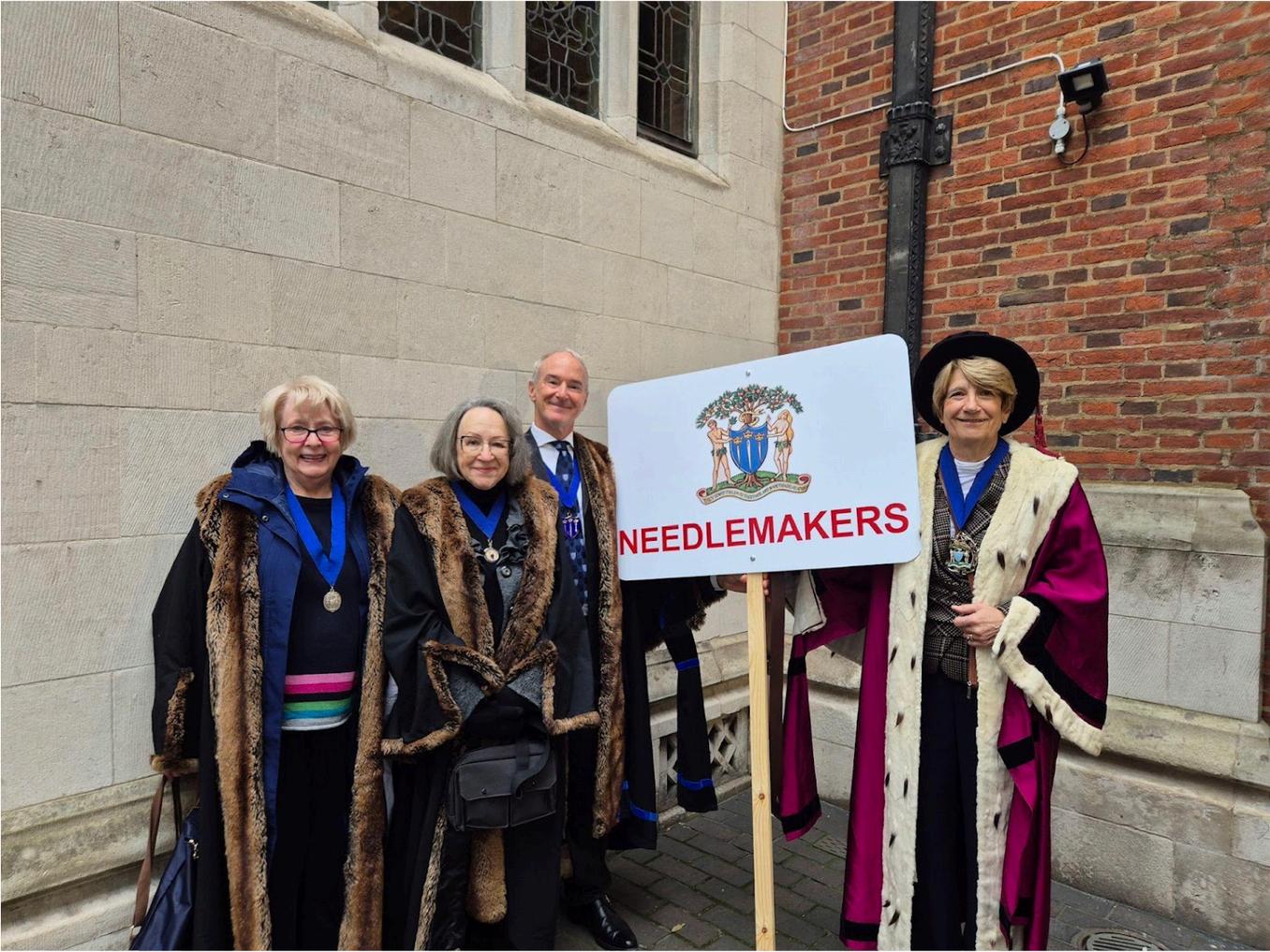
Many liveries proudly carried a wooden banner bearing the company name, and the Master deftly took charge of ours, despite having
warned me that – as our sole male representative – I should expect an arduous day of carrying duties. There was much sizing up of robes and hats, with the first prize for the most eye-catching hat going to the Master Gold and Silver Wyre Drawers, though we can lay claim to a prize for one of the finest Master’s robes. Sue’s imperial purple and ermine trimming certainly stood out beautifully, and once the Master had passed on the banner-carrying duties to me on the return loop, she was much in demand for high fives with the front row spectators.
As they set off and turned the corner into Princes Street, heading towards Mansion House, the team was thrilled to experience the warmth of the crowds. At many places, the spectators were three or four deep, with boisterous children acting as cheerleaders. There were a fair number of international tourists, who seemed both bemused and delighted at what they had encountered, leading to much video-taking and animated pointing! And we appreciated the vociferous support of our very own cohort of well-wishers, comprising liverymen (including one of our newest intake, Raz Kaushik), consorts, friends and family.
After an hour or so we approached the Royal Courts of Justice. Conveniently, we had a booking at
the Worshipful Company of Carmen for the chance to sit down and warm up. We helped ourselves to lunch from the buffet, and were surprised and indeed very happy to find that we could slip into the pews of the adjoining St Dunstanin-the-West to tuck into it. A member of the Worshipful Company of Musicians sat down at the Church’s baby grand piano and delighted us with a medley of what might best be described as salon music! Suitably replenished, we headed back outdoors and spent a few minutes observing the procession as it reached its pinnacle, culminating with the 696th Lord Mayor, Alderman Alastair King, in his splendid gold coach, waving effusively as he acknowledged the crowds.
The return leg along Victoria Embankment and Queen Victoria Street was a breeze after our fortifying lunch, and we all felt uplifted at being part of such a unique occasion – the oldest civic procession in the world, if the PR is to be believed!
A note: Liveryman (and newsletter editor) Kimball Bailey was several hundred yards behind the Needlemakers’ team and banner in an open-top bus, and can attest to the temperature! We clearly have a gallant and hardy membership.
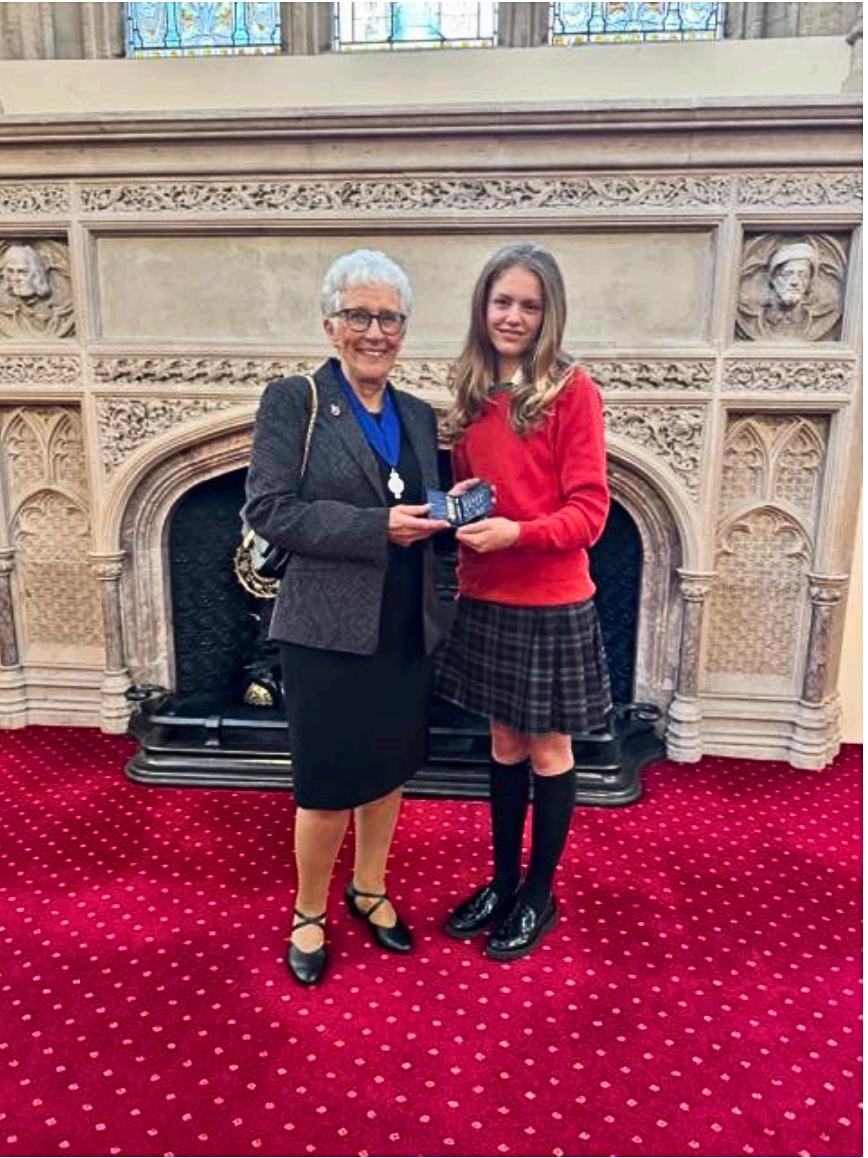
Honorary Almoner GILL LOFTUS was pleased to represent the Master at the 2024 CLSG Prize Day, held as usual in Guildhall. The prizes were presented by TheLordMayorLocumTenens,AldermanSirWilliamRussell.

AFTER a welcome speech from the Chairman of the Board of Governors, Alderman Robert Howard, we heard from the Headmistress, Jenny Brown, about CLSG’s achievements this year. In a speech summarising important changes that have enriched education at City, Jenny proudly announced that Years 12 and 13 are now happily installed in part of the old Museum of London site. This has eased the pressure on space in the School’s Barbican building, which opened in 1969. The City Corporation approved the application in April, refurbishment work began in June and the building was ready for occupation in September – that’s how to get things done in the City!
Interspersed with the presentation of prizes (no less than nineteen were gifted by Livery Companies),
we were treated to some wonderful music and inspirational modern dance. After the proceedings, we all retired to Guildhall Library for a delicious tea, and I managed to find Amelie Helbig, the winner of our prize and needle case, which this year was awarded for exceptional achievement in music. Amelie is a member of several choirs; she is also a soloist, and this summer performed a Bacchanale in a church in Germany. Amelie was absolutely thrilled with her needle case, and her mother, Elvine (also pictured), had explored the Company website to find out more about the Needlemakers.
In her email to me afterwards, Amelie said “I felt truly honoured receiving this prize from a Livery Company that has been around for such a long time, it made me feel like I was a part of history!”
The Needlemakers met on 22nd January 2025 for our January lunch at the splendid Cutlers’ Hall, under a hammer-beam roof and surrounded by wooden panelling and a distinctive elephant motif. Past Master PHILIP LAW was one of thosewhoenjoyedthefestivities.

THE LUNCH followed the first Court Meeting of Sue Sumners' year as our Master.
At the lunch, we were all delighted to recognise Dr Susan Kay-Williams as a new Court Assistant. The final agenda item for the Court Meeting was the clothing of four new Liverymen, who were subsequently given a hearty welcome at lunch. They are (as pictured L-R flanking the Master) Richard Yarwood, Christine Coultrup, Emily Sumners and Catherine Dormor, and short
biographies of all four can be found in the “New Friends” article later in this newsletter.
Fine Cell Work, one of the charities and social enterprises that Needlemakers support, displayed and sold some of their hand-made craft items.
We were treated to a brief history of the Hall by the Assistant Beadle of the Cutlers over a refreshing glass of
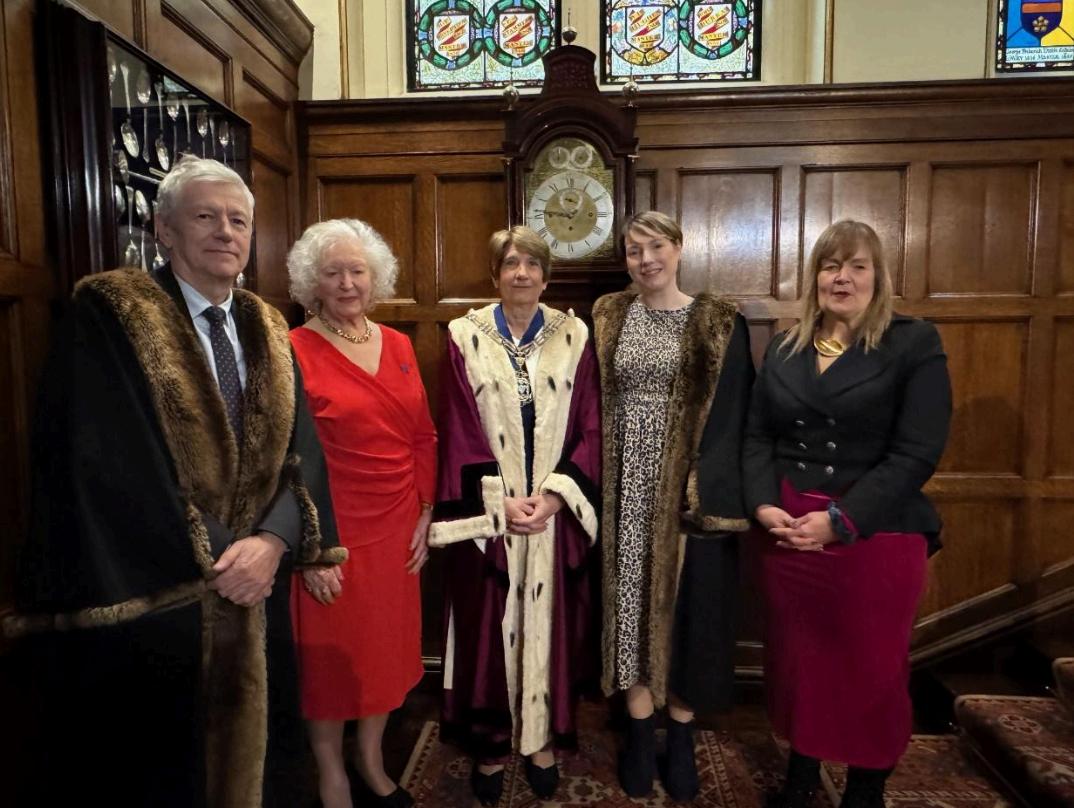


fizz, then made our way up to the Dining Hall, which was both pleasantly full and pleasantly warm on such a cold day.
On the stairs, we passed some fabulous stained glass and a number of swords made by the Cutlers for Viscount Montgomery of Alamein, Lord Horatio Nelson and Edward, the Black Prince, son of Edward III. It was hard to prise your editor away from the last of these which was made in the 1370s, almost 300 years before our own sixteenth century Charters
An excellent meal was book-ended by a speech by the Master and a most interesting talk by the guest speaker, Neal Dodge. Neal is one of the bellringers at our Livery Church, St James Garlickhythe. Of particular interest were the eight Royal Jubilee Bells in the church, the largest of which weighs half a ton, which were first rung on 4th July 2012 as part of the late Queen's Diamond Jubilee celebrations, and which also featured in a record-breaking peal in 2013.
The next Court Lunch will be on Friday 11th April at Trinity House.

22 Liverymen and their guests, including more than a smattering of Past Masters, gathered at the Ironmongers’ Hall on a Monday in November for a splendid lunch. SARAH ROBERTS, who became a Liveryman in 2007, was one of them.
AMOST ENYOYABLE lunch was held at the Ironmongers’ Hall in November. This is a much-
appreciated get-together, as many of us now find the journey to London a step too far to attend Needlemakers’ events. Sadly, my husband Barrie was himself unable to attend. We all much appreciate being able to come and see old friends at the lunch.
This time we numbered 22, of whom four were over 90! It was especially nice to be joined by our Master, Sue Sumners, and her husband David.
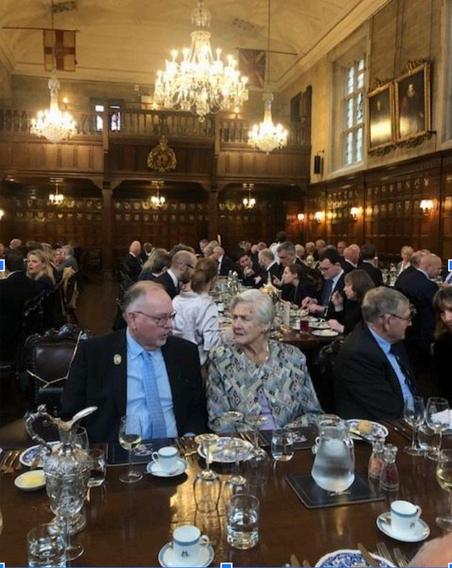
All thanks to Gill Loftus, the Honorary Almoner, for arranging this event, and to the friendly Ironmongers’ staff for

for providing such excellent service. The photographs illustrate a very happy occasion.
Along with everyone else, I’m much looking forward to our next get together in May.
The attendees were the Master and Consort, Sue and David Sumners; Ana Barber, Pauline Boon, Shirley Born, Betty Copsey and her daughter Jo Hoar, Carolyn Ezekiel, Colin and Susan Finch, Tony Floyd and his daughter Claire, Jackie Foster, Simon Fradd, Chris and Eve Frankland, Jim and Brenda Laing and their son Richard, Gill Loftus, Colin Tiffin and me.
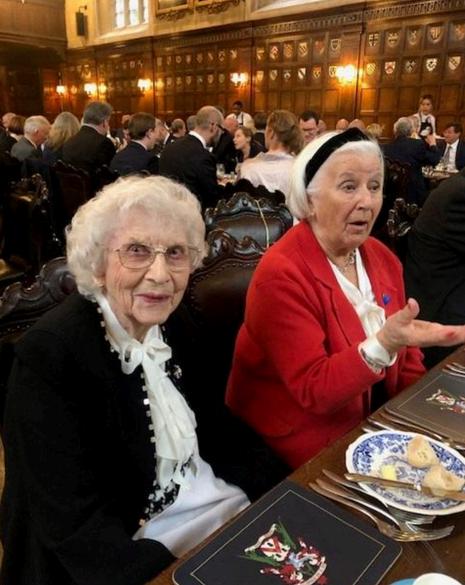

Inter-Livery sport continues to flourish, and Assistant CHARLES BARROWS represented the Needlemakers in the Real Tennis Championship at Queen’s ClubinNovember.

THIS WAS the seventh annual Inter-Livery Real Tennis Championship, organised by
the Skinners and Barbers, and generously sponsored by Pol Roger and Thomson Tyndall. Nearly 100 people from 23 Livery Companies played in two groups. It was quite an event, on a fine autumn day – with the courts being indoor, of course.
Each pair played three matches for 25 minutes per match; thereafter, the top four from each group played knockout games. The scoring was complicated, but thankfully the Accountants and Actuaries helped us out, and the Apothecaries were in attendance to help treat injuries.
Charles was sadly unable to find
another Needlemaker to play with, but a friendly Clothworker, Liveryman John McVittie, had a similar dilemma and, perhaps naturally, he and Charles made quite a good team!
Alas, they didn’t make it through to the knockout stage, but had good games against the Apothecaries, the Skinners and the Chartered Surveyors. The eventual winners were the Mercers and the Skinners (taking full advantage of their victory over us) 15 different Companies have won in the seven years the event has been held, with only the Skinners – appropriately perhaps, as organisers – having won twice.
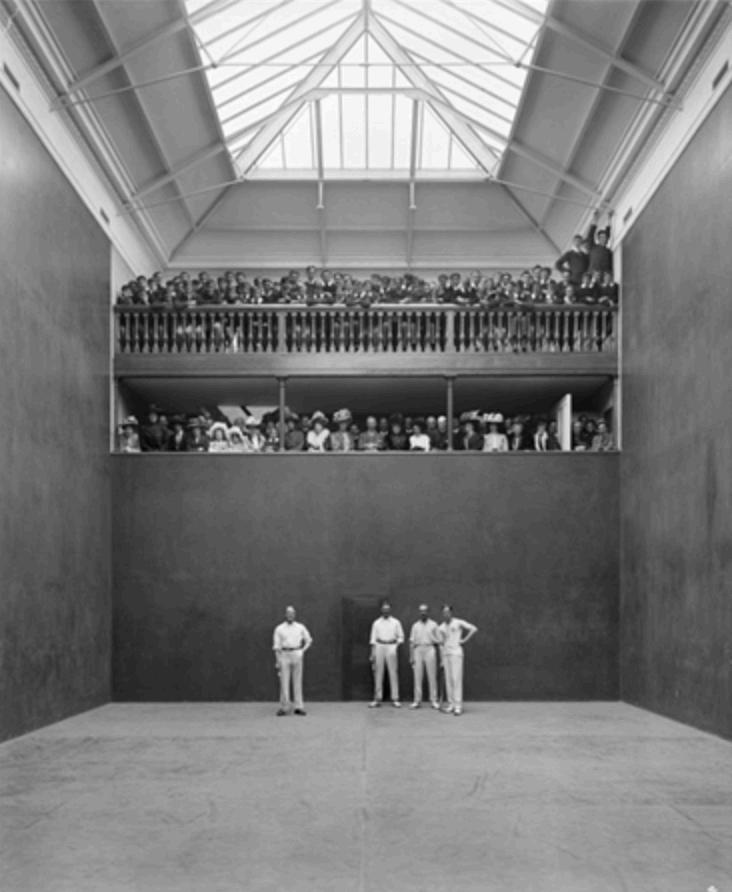
A grand trophy black tie dinner was held that evening in the President’s Suite at Queen’s Club, and a fine time was had by all, helped somewhat by the champagne Pol Roger so generously donated.
If anyone would like to participate next year, or indeed would like to try their hand at Real Tennis, then do please let Charles know. He fully intends to walk away with the trophy next year (and needs all the help he can get – Ed.)!
As much of this newsletter is finalised in January, over 200 Inter-Livery skiers will be in Morzine – the Needlemakers are keen to raise a team for the Inter-Livery skiing in Mayrhofen in January 2026, so please contact Charles if you are interested in that too.
Every so often our Honorary Archivist, ANGIE LEWIS, receives an enquiry from a member of the public engaged in genealogical research and seeking a connectionwiththeNeedlemakers.Thisisthestoryofoneofthoseenquiries.

Elizabeth Gilmore has positively identified all four people in this picture. On the right is her paternal grandmother, Elizabeth Habgood (1875-1961), along with her parents John Lane Habgood (1823-1917) and Elizabeth (1825-1924), and her sister Eliza Frances (1876-1963), Elizabeth’s great aunt. John Lane Habgood is the great great grandson of Edward Habgood, PM William’s great great nephew.
IN OCTOBER 2024 we received a query from Elizabeth Gilmore, who has lived in Orkney for the
past 24 years and is involved with the Orkney Wireless Museum. As an aside, one of her roles includes changing the needles in the wind-up gramophone! She had arranged to meet an old school friend in Redditch, near her old home town. As she enjoys small museums, she decided to make an unplanned visit to the Forge Museum. Until this visit, she had had no idea of the family connection with needles, despite having researched her family’s past for some years.
While in the Museum, Elizabeth spotted the display board about the Worshipful Company of Needlemakers. She read that, in 1786, the Master of the Needlemakers' Company was one William Habgood. For Elizabeth, this was a fascinating coincidence as she knew, from earlier research, that a William Habgood (1744-1803) was one of six sons of her five-times great-grandfather, James Habgood (1707-1789), a very prosperous haberdasher. One of the other sons, and so William’s brother, is Edward Habgood (1736-1811), who became a baker. Elizabeth is directly descended from that Edward.
Elizabeth thought the connection was too good to be true, so asked the museum curator to put her in touch with us.
We confirmed the basic information
from the record cards manually completed – from old Court Minutes from 1594 to 1974 – by our first Honorary Archivist, Veronica Stokes. These have now all been scanned and, more recently, linked and listed digitally by name/date in our database. The scan of William Habgood’s record card is pictured.
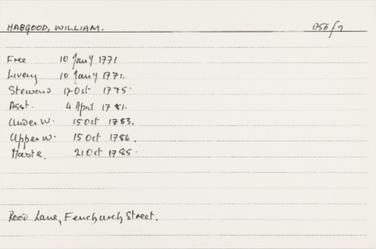
In addition, Elizabeth’s own online research had unearthed an article –“Habgood versus Habgood” – written by Judith Everett (née Habgood) who has researched on the Habgood history. This excellent research was carried out from analysis of the original source documents, fully referenced rather than internet hearsay. Judith has generously put her work online. Both Elizabeth and I are in touch with Judith to share our findings, now and in the future, to populate our own records further. Judith has kindly given her permission for me to provide the link to you, for your interest.
A chance visit to the Forge Museum, where Elizabeth recognised a family name, has fortuitously led to a link between names and dates on her family tree and on our database, and those names have now become real people!
And thanks to Judith’s work, the story becomes yet more interesting. Little did Elizabeth imagine that her Habgood ancestors had such a colourful past!
Here is the link to Judith’s work on the Habgood family:
Habgood versus Habgood in Chancery –judithhabgood.freemyip.com
The introduction to this somewhat salacious history reads:
“This is the true story of a series of catastrophes which befell the Habgoods of London and Latton between 1800 and 1890, including the acquisition of a large fortune by a London businessman, his suicide in 1803, the inheritance of the fortune by three orphan children, seduction, bankruptcy, imprisonment, bigamy, polygamy, ownership of a factory producing drugs, elopement with an heiress, more imprisonment, strong indications of murder, authorship of a book now considered to be of historic importance, the acquisition of another fortune, the purchase of a private bank, election to Parliament, an article in The Times accusing the MP of owning a brothel, the insolvency of the bank, riots in the streets, a possible
suicide, eviction from a manor house, more bankruptcy, more bigamy, and finally death in a workhouse. Much of the villainy was perpetrated by George Muskett, MP for St Albans, and also by William Milburn, a trader with the East India Company, who wrote a book about the countries of the east.”
What a tale! Certainly “something sensational to read in the train”. And hopefully the subject of another article…
While much of the story is about the events around and following William Habgood's death, Judith describes our Past Master as a thoroughly decent man who used the money he made to care for his family back in Latton and in London.

The second chapter describes William’s start in life as apprentice to a Needlemaker. Here is an excerpt:
“William the Needlemaker: In 1760. James Habgood had decided that his son, William, would be apprenticed to a Needlemaker called James Shaw, who lived in London. William would stay in James Shaw’s house for seven years, and would work for him, gradually learning the trade of haberdashery: what the different cloths were used for, where to buy them, who to sell them to, what prices to pay, what profits could be made. James paid a fee to William’s new master, and William signed the apprenticeship agreement. James then said goodbye to his son, and left him with his master in the biggest city in Europe to learn the trade in which he would spend the rest of his life. How huge, how dirty, how exciting London must have appeared after life in the tiny village of Latton. William started upon his seven years’ training. The life of an apprentice was full of prohibitions: he must not waste the goods of his master, nor commit fornication, nor marry, nor play at cards or dice; he was not allowed to frequent taverns, but ‘as a faithful apprentice he shall behave himself’.”
Each of us who is a Liveryman will have been handed similar rules when receiving his or her Freedom of the City of London!
Past Master William Habgood's death was also reported in a newspaper and Judith has a copy of the post mortem after his suicide, his will (which is not valid) and a 40-sheet inventory listing all his possessions at the time of his death, and also listing all the people he traded with across the South of England
His death was followed by his children being made Wards in Chancery. His daughters eloped with disreputable men: both were bigamists, and one was suspected of the suspected murder of one of the girls.
The earliest Habgoods noted in the family tree put together by Elizabeth were based in Latton, Wiltshire, where Elizabeth also found the family graves. They are in the church of St John the Baptist in Latton (pictured).

The gravestones are in a very poor state, but sufficiently legible to decipher that they are the graves of Past Master William, his wife Mary, and Elizabeth’s direct ancestor, Edward. In the photograph (taken by Peter Stokes on October 2024), you might be able to make out the word 'London'.
We are still trying to track down a verifiable painting of our Past Master!
As Honorary Archivist, Angie has spent years populating names and dates from the distant past into spreadsheets and scans. Elizabeth Gilmore’s chance enquiry has led to a fascinating journey for her as well as for Angie, for whom it has been a real pleasure to bring the bare bones of our records into such life. The more we can record and collect in terms of pictures and experiences of all our Liverymen, whatever formal positions they have held or hold, will certainly give a fuller picture of life for the future readers of our records.
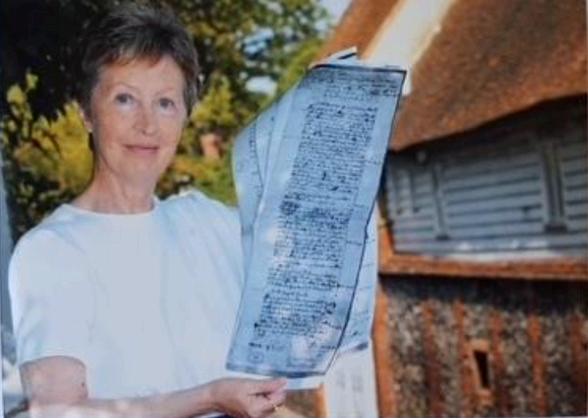
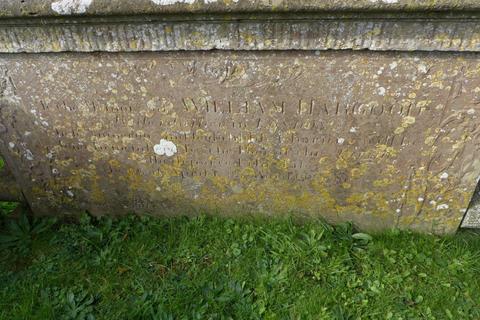

Liveryman Stewart Katz was tragically severely injured in a motor accident near his London home in March last year. The incident is the subject of an ongoing police investigation. He remained in hospital on life support for several months but,despitevariousmedicalinterventions,diedinOctober2024.
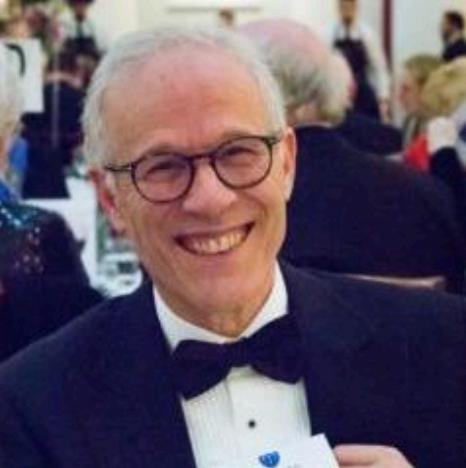
GILL LOFTUS, our Hon. Almoner, is indebted to Stewart’s ex-wife, Celeste
for the brief glimpse of his life that follows. Although divorced many years ago, Stewart and Celeste remained close friends.
Born in Reading in 1946, Stewart was a pupil at Brighton Hove and Sussex Grammar School for Boys and, having qualified as a chartered accountant, set up his own company, Katz & Co., in Notting Hill Gate. He remained close to his brother, Daniel Katz, legendary art dealer and collector whose Mayfair gallery is renowned. Stewart, by contrast, retained a keen
interest in anything scientific. He never lost his love of reading and learning, was great company and would happily converse on any topic.
He was a Friend of Imperial College, a member and supporter of nearly every museum in London, along with several wildlife organisations, including the RSPB. He was a lifelong supporter of The London Wetlands Centre in Barnes and went there regularly with his daughter.
He played tennis for many years and more recently was a table tennis enthusiast, playing three times a week. He was also an active member of more than one bridge club.
Stewart applied to join the Needlemakers in September 2010 and was granted the Freedom of the Company in October that year. He was clothed at Court in April 2011 together with Gill Loftus and Valerie Wilkins. He attended the Banquet and was interested in the charitable work of the Company.
Our thoughts and prayers go out to Celeste and to his daughter Rebecca, who shared his love of wildlife.
Paxton & Whitfield, established in London in 1797 and perhaps the most famous cheese emporium in London if not the world, was the venue for our January tasting. Assistant PIPPA ROUSSELET, Chair of the Functions Committee, was there,andLiverymanKIMBALLBAILEYwasthereinspirit,viaZoom.
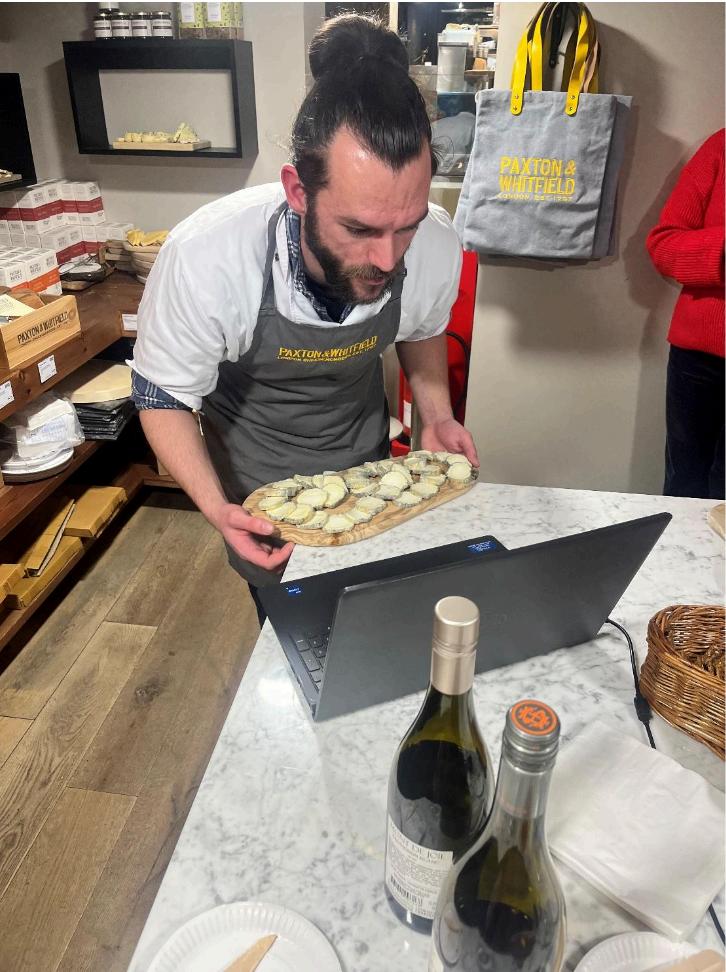
THIS WAS our first hybrid event, with Liverymen joining the Jermyn Street contingent
online, via Zoom.
We were expertly guided through our tasting by Daniel Iliev (the Young Cheesemonger of the year in 2024). Daniel gave us a short history of cheesemaking before revealing the traits of individual cheeses.
We tasted six cheeses – those at home had had the same selection delivered in a timely manner: a delightfully runny Brie de Meaux; an Erlick Log (a Scottish goat), a Lincolnshire Poacher (Cheddar style); a Reblochon; and two Stiltons, Colston Bassett and Cropwell Bishop, so we could compare and contrast. And all were excellent. There were lashings of Sauvignon Blanc and Pinot Noir to help us wash down the cheese, with those at home also able to have a glass or two.
As ever, it is the trivia that remains in Pippa’s mind. Who knew that Reblochon was invented in Savoie as


a tax dodge? The locals kept back some of the milk they declared to the authorities for making Comté and then made Reblochon on the sly for their own consumption. Who knew that the French claim to have invented Cheddar? They have suggested that Cantal was the original, and that “Cheddar” actually refers to a cheesemaking technique rather than a geographical area.
Who knew that you can’t make Stilton in Stilton? Leicestershire, Derbyshire and Nottinghamshire, yes, but only those: the village of Stilton is now in Cambridgeshire.
And here is something to think about. The blue veins in Stilton-type cheeses are made using needles. Perhaps this offers an opportunity for the Livery to sponsor an annual Stilton competition, which will of course involve a considerable amount of sampling to come to a decision!
A splendid evening and our thanks again to Daniel and to Paxton & Whitfield.

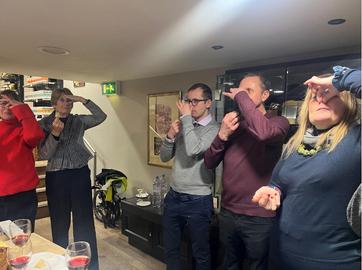
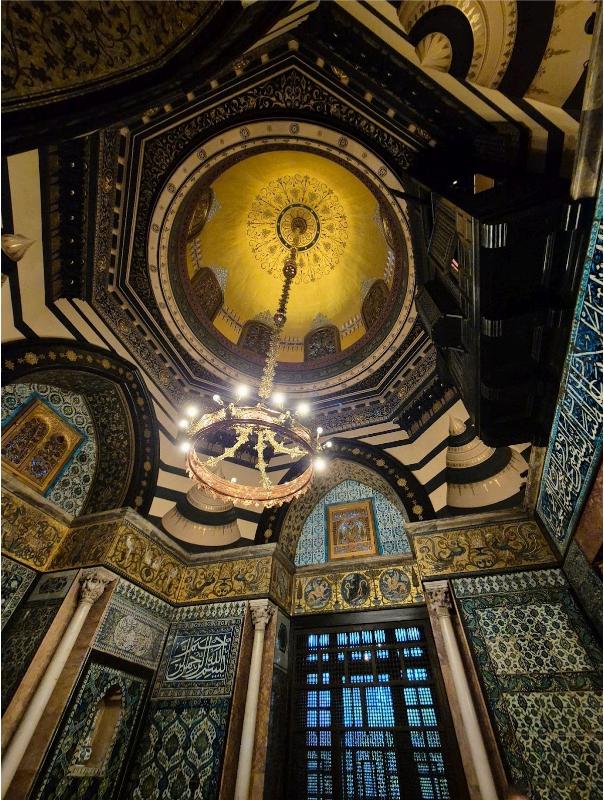
Assistant PIPPA ROUSSELET, Chair of the Functions Committee, highlights one of our recent interesting and informal social events, and encourages us to shareinthefellowship.
OUR VISIT to the House of Lords sadly had to be postponed. As an alternative, the Functions Committee organised a guided tour of Leighton House, built in Holland Park by the eminent Victorian painter and sculptor, Sir Frederic Leighton.
Angela, our excellent guide, talked us through the evolution of Leighton House. She explained that while the initial house was relatively modest, consisting of a dining room, drawing room, breakfast room and staircase on the ground floor, there were just two rooms upstairs: Leighton’s great painting studio, and his surprisingly modest bedroom.
Within three years of being completed, Leighton undertook the first of a series of extensions and alterations. To increase the size of the studio on the first floor, the east wall was taken down and the house extended by five metres. The extension incorporated a new canvas store accessed via a trapdoor in the floor of the studio, and gave the models a side entrance to the studio via the service staircase.
Leighton travelled extensively in the Orient, particularly to Turkey, Egypt and Syria, where he collected textiles, ceramics and other objects. In 1877, he began the construction of the Arab Hall to display his extensive collections. The Arab Hall became his principal entertaining area, and the parties were so raucous that guests
are known to have toppled into the indoor pond, much to the surprise of the resident goldfish.
The last addition to the house was the Silk Room, designed as a picture gallery to house Leighton’s expanding collection of paintings by his contemporaries. The walls were lined with green silk and the artists represented included many of the leading painters of the day: John Everett Millais, John Singer Sargent and George Watts, as well as his own compositions.
Please look out for announcements about future events, sign up and bring a friend – who knows, we may attract a new member or two?
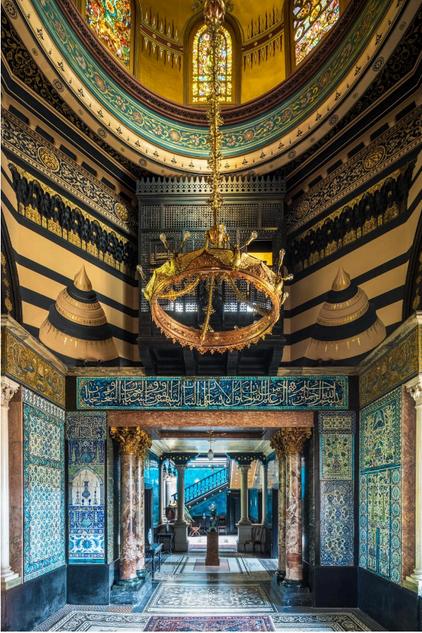
Our Beadle for the last 11 years, JOHN OAKLEY, was installed as Chairman of the City of London Beadles’ Guild at Mercers’ Hall on 17th January 2025. John tellsusmoreabouthisinstallationandthehistoryoftheGuild.

IWAS HONOURED and delighted to become Chairman of the Guild, which represents not only the 112
Livery Company Beadles, but also the 25 Ward Beadles.
I am particularly grateful to the Worshipful Company of Needlemakers for appointing me to my first role as Beadle in January 2014, which set me on the road to my elevation as Chairman of the Beadles’ Guild. My background was as an estate agent, eventually becoming Managing Director of a six-branch practice in Kent and Sussex. Having sold my interest in 1998, I was too young to sit at home doing nothing, so became a part time marriage registrar (which I still do). This introduced me to toastmasters and hence to Beadles, and what fun it has been.
The Beadles’ Guild was formed to create an environment where Beadles could meet socially, maintain standards throughout their role in the City, uphold tradition and also raise funds for charity, most notably The Lord Mayor’s Charity and the Chairman’s chosen charity for their year – mine is The Lullaby Trust. They are also there to assist and mentor new Beadles, and to provide backup to Beadles who are not able to obtain cover for a function.
The Guild also organises an Annual Beadles’ and Clerks’ Lunch when, for once, we don’t actually have to do anything! Apart from the Beadle who has to Beadle a Beadles’ function!
has to Beadle a Beadles’ function!
While the Beadles’ Guild has only been in existence for some 34 years, Beadles have been part of the Livery movement since the 12th century. They were appointed to act as a central point of contact within each Company – in fact the role of Clerk was not appointed until much later. The Beadle took care of the Company’s meeting place, called the Court or Livery, on behalf of the Master, and enforced any disciplinary measures decided by the Court. He was also responsible for recruiting potential Apprentices, and carried a staff of office – or stave – to protect the Master and Wardens and to keep order among the Apprentices. Beadles were also keepers of ceremony and tradition, hence the Beadles’ Toast which is given at Beadles’ Guild functions: the one word, “Tradition”.
While these days the role of Beadle is mainly ceremonial, in times past they were the Company’s policeman. Beadles are still required to keep order and coordinate and manage the various Court meetings and events that are held. One of their most important (and sometimes most difficult) roles is timekeeping for functions – especially the first call for dinner when the guests are deep in conversation and are in no hurry to go in, and then at the end of the evening when, having enjoyed good food and fine wine, they are in no rush to leave! With diplomacy and tact, not to mention the rather imposing staff of office, the Beadle will encourage them into dinner and
tact, not to mention the rather imposing staff of office, the Beadle will encourage them into dinner and then out of the premises at the end of the evening. The duties of the Beadle do not end there, of course, because they are responsible for ensuring that
they are responsible for ensuring that the Company gowns and treasure, which they brought along at the beginning of the day, are securely returned to the storage vaults where they are kept.

“Learn to make a needle cushion,” they said. “No experience necessary,” they said. “It will be fun,” they said. They were right, as Liveryman NOLAN SHAW –oneofthosewhoattendedtheCraftWorkshopinFebruary–wastofindout.
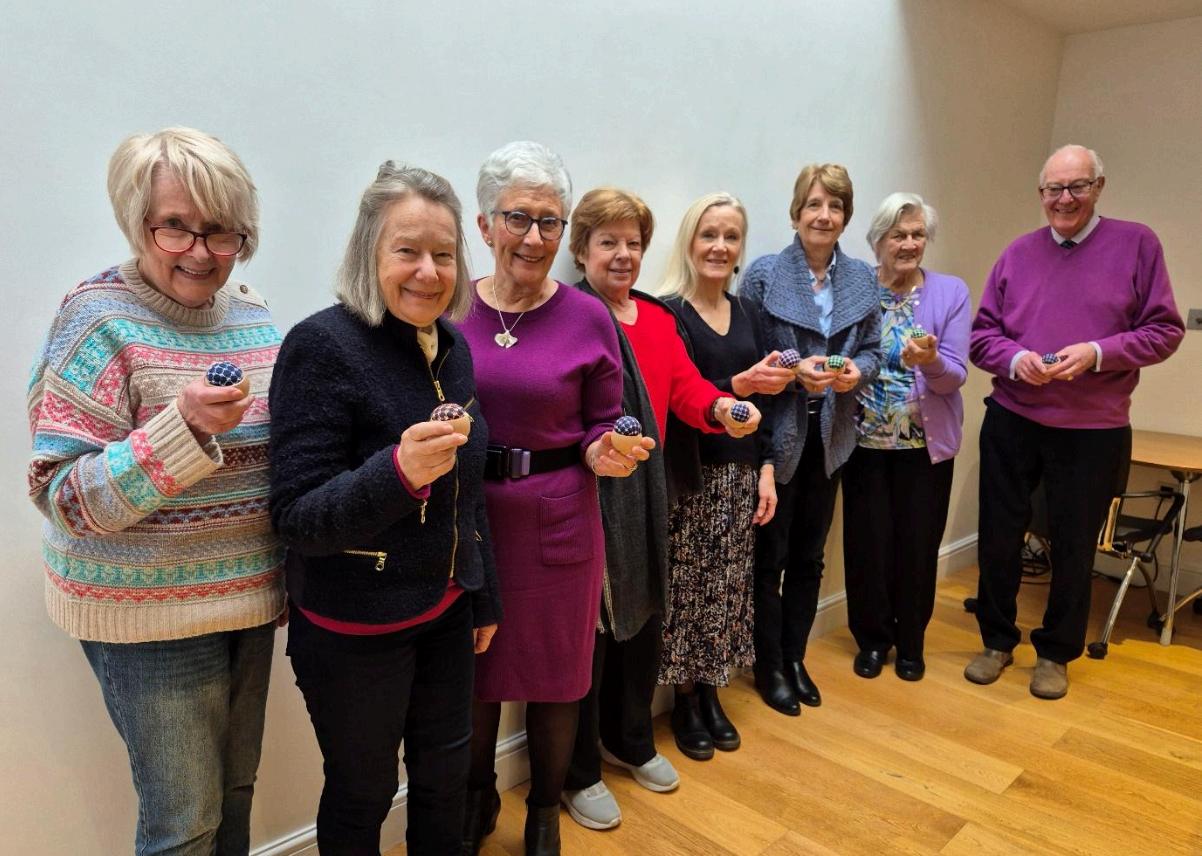
PAST MISTRESS Elizabeth Whitton had previously created a craft workshop to
make needle cushions as an event for consort guests of Past Consort Kim Riley in 2023. That was great fun too, as your editor (a Past Consort himself) can testify.
It was time to run it again, this time for Needlemakers, as we remembered the motto on our own coat of arms.
A group of us assembled for the workshop at some very smart offices, courtesy of Past Master Andrew Whitton, for which our thanks.
The Japanese sewing technique that we were taught – Sashiko – is a form of Japanese mending and embroidery that was used during the Edo period (1603-1868), and that is still in use today. It is sobering to think that the technique dates back to before 1656, the year of our own Commonwealth Charter. At that time Edo was a small village in Japan; now it is modern-day Tokyo.
Sashiko was used by fishermen and farmers to strengthen clothes. Old worn-out clothes were pieced together to make new garments by using simple running stitches no bigger than a grain of rice. The poor were only allowed to use white thread. By using these stitches in different directions, they formed different patterns.
Elizabeth showed us a most impressive display of some of her own Sashiko creations, so we could see a wide variety of designs, and it was surprising to see quite how many possibilities there are in these different designs.
Elizabeth, aided by Kim, welcomed us with a generous selection of delicious pastries and coffee. They then told us about Sashiko, after which Elizabeth took the session, very patiently showing us all how to create our own needle cushion. We were given kits that she had previously put together, and were shown the basics of how to use a needle threader, twang our threads and tie knots, after which we were taught what seemed a fairly intricate pattern for our needle cushions!
Then we were off. We had a delightful morning chatting away and were very pleasantly surprised by –and even proud of – the results. Expert help along the way made it all possible, even for the absolute beginners. Our Master, Sue Sumners, closed the workshop with thanks to Elizabeth, Kim and Andrew, and we are looking forward to another possible workshop in the future.

Eleven new Liverymen have been clothed as Needlemakers since September 2024, and several new Freemen have also been admitted to the Company. We highlightafewofthenewfacesandbidallofthemaheartywelcome.
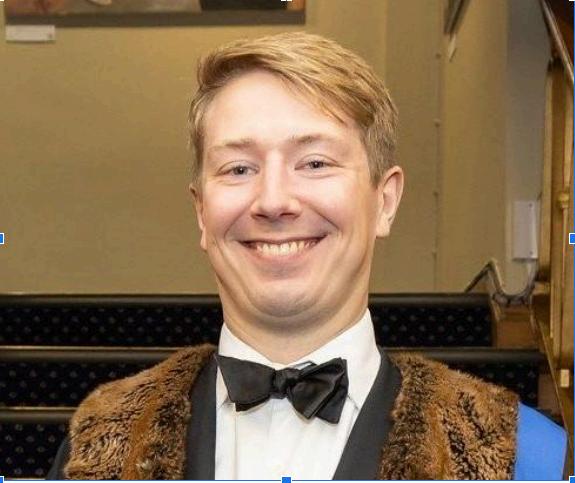
Liveryman;proposedbyJohnScott
WILL ANSLOW-WILSON was educated at Pangbourne College and Newcastle University, reading Geography and Planning
He started his career at Thompson Heath & Bond (now Amwins) as an insurance broker, specialising in placing North American directors’ and officers’ liability insurance (D&O) He now works at Marsh McLennan, having joined Marsh’s financial lines practice in London in 2021, where he focuses on D&O in emerging markets and for challenged and complicated risks. He would like to work overseas in the near future
Will joined the Needlemakers to become part of the rich history and tradition of the Company and the City, as well as to engage in philanthropic activities. He continues a long family tradition of Anslow-Wilson Liverymen at the Needlemakers
A former rower, he now lives in Putney, and spends most of his spare time cycling, shooting, hiking, or learning new sports and activities, most recently surfing in Sri Lanka.

Liveryman;proposedbyGillLoftus
CHRISTINE COULTRUP grew up in post-war Britain watching her mother making clothes. The sound of her manual sewing machine was background music from an early age. She taught Christine all kinds of needlework which became a lasting enjoyment.
Christine went to the City of London School for Girls where she developed a love of the City, becoming a Freeman of the City of London in 2012, joined the Guild of Freemen, and is delighted now to have been admitted to the Needlemakers.
She and her husband set up a company selling engineering equipment to the oil and gas industry, starting out during the early period of North Sea developments, and was twice helicoptered out to offshore platforms. She was a director of the Energy Industries Association, and the first female Chairman of the Gas Processors’ Association Europe Christine lives on the Essex/Herts border, where she plays bridge, produces a village magazine, and, of course, does embroidery.
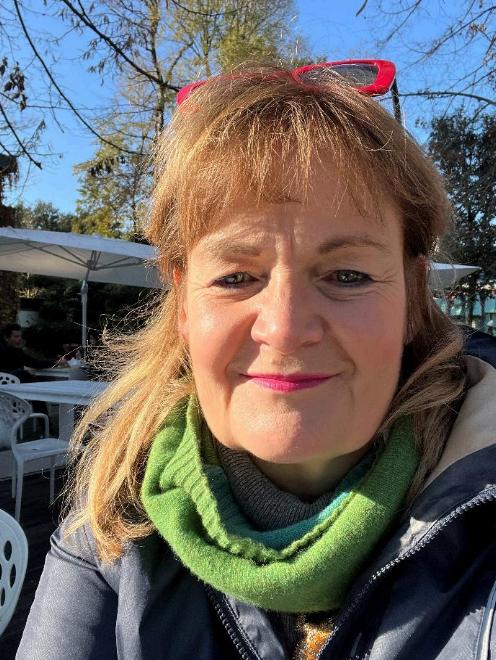
PROFESSOR CATHERINE DORMOR is a textile artist, academic and writer She is Professor of Textiles and Feminisms at the University of Westminster, where she is also Pro-Vice Chancellor. Her artworks and research are focused around the capacity of cloth and stitch to offer language for what it means to be a community, where warp, weft, thread and needle move within and between one another to create new structures and surfaces for delight Having originally studied and taught maths and statistics, Catherine embarked upon a textile career when her daughters were young, eventually receiving her PhD by Practice from the University of the Arts London and Norwich University of the Arts This journey began with ecclesiastical embroidery and the very fine needles needed to stitch down gold threads delicately, row by row, with waxed threads. She still is beguiled by the beauty and ceremony of this work She exhibits artworks regularly with the 62 Group of Textile Artists and is currently their chair. Catherine looks forward to engaging with various aspects of the Company, but perhaps naturally the educational will be a particular draw. She lives in Peckham with husband Duncan. They have two daughters, a granddaughter and one more on the way. She loves art, food and shopping, and so is particularly fond of Italy
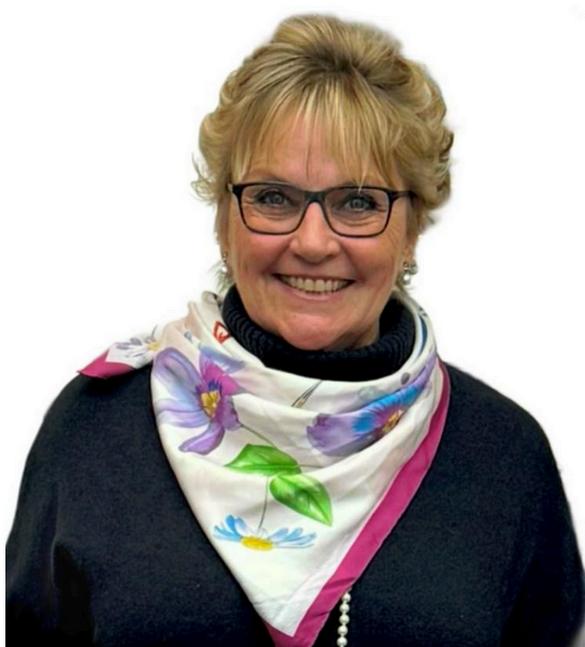

CAROLINE GREEN is Essex born and bred, and graduated with a degree in Mathematics and Computer Science from Queen Mary College London. Having worked for several financial institutions, Caroline became a Futures and Options Broker on LIFFE (London International Financial Futures and Options Exchange) until August 1995. Married to Richard, Past Master Chartered Accountant (2023), Caroline became more aware of the Livery Companies and their involvement with the Lord Mayor and the City of London, the Armed Forces and charitable causes. In preparation for her time as Mistress Chartered Accountant, Caroline joined City Consorts, a society formed for all Consorts to give them the confidence and knowledge to embrace and enjoy their year as Mistress/Consort.
Caroline is now a member of one of the committees of City Consorts. Having formed friendships with several members of the Worshipful Company of Needlemakers, Caroline was absolutely delighted to be welcomed into the Company and to be clothed as a Liveryman.
Caroline and Richard have recently moved to Poole with their three dogs Their son lives in London and, very kindly, provides a London base for them. She enjoys travel, swimming, skiing, cooking, singing, sewing and knitting

Liveryman; proposed by Philip Law
RASIKA MEENA KAUSHIK (RAZ) was born in India and grew up globetrotting, with her father being a Naval Attaché
A Civil Servant in her day job, Raz is currently a Senior Policy Advisor in the Deputy Prime Minister's Policy and Data Unit, also deputising as needed in Number 10's legislation and briefing units Raz is also an Honorary Fellow of the Hansard Society for Parliamentary Democracy, and sits on the Shadow Board of MHCLG, the Department for Housing, Communities and Local Government Outside work, Raz lives in Westminster and is a trustee of Age UK Westminster, a School Governor, an avid reader, a cricket buff, and a regular at Ascot. She has a love of languages (speaking 14 of them) and of music (opera and the classical sort in particular), theatre, ships and sailing! She has recently become a Fellow of the Royal Society of Arts (FRSA).
She felt called to be a Needlemaker because of the fellowship, the company's industrial heritage, and the more recent emphasis on needle usage for medical purposes, given her own recurring need for injectable medication. For Raz, it is an opportunity to engage and make a meaningful contribution to the fraternity that goes deeper than a donation.
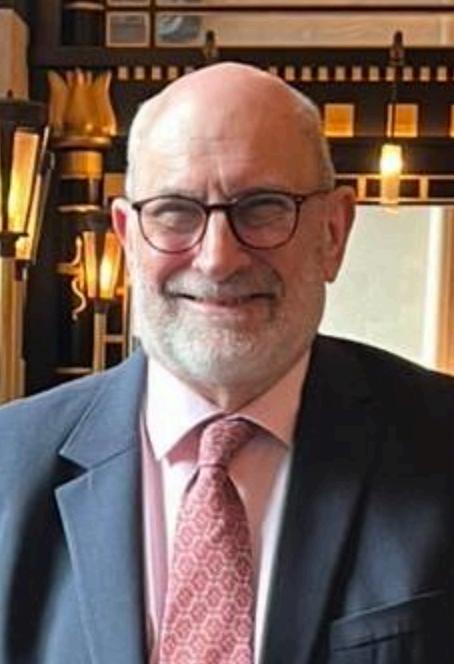
TERRY NEVILLE OBE was born and grew up in Rayleigh, Essex He retired in 2022 after working for 53 years in higher education in senior positions, including Deputy Vice Chancellor. He worked at the Universities of Birmingham, Hertfordshire, West London and Northampton, and at Imperial College, London. He is still a Fellow of the University of Hertfordshire.
He also held leadership positions in university consortium developments in the areas of procurement, insurance, and transport. He was chairman of Unobus, an independent bus company. He led major capital developments at the University of Hertfordshire’s de Havilland Campus and the Waterside Campus Development in the Northampton Enterprise Zone.
His interest in the arts began with the IKON Gallery in Birmingham, where he was Company Secretary. He developed various arts and cultural programmes at Imperial College, Hertfordshire and Northampton Terry has been a supporter of Southend United since the mid 1950s. He is a horse racing fan and a member of a club that has three horses in training He enjoys cricket and is also a vice president of Letchworth Garden City Rugby Football Club, a local club close to Hitchin where he lives with his wife Fran.
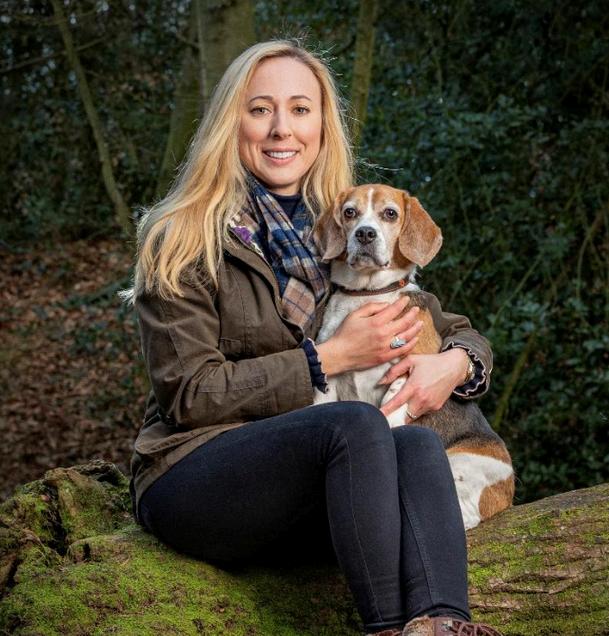
VICTORIA PAGE was born in Bedford and currently lives in a village in north Bedfordshire with her beagle, Hawky. They both enjoy lovely walks right on their doorstep. Victoria was educated at Bedford High School for Girls and, after completing her A-Levels, went straight into employment. She began her working life as a Premier Beauty Therapist at Champneys and has since transitioned into the technology industry, where she has been working for over fourteen years She is now employed by a global technology firm based in the City of London as a Delivery Lead, contributing to major change programmes for clients in the financial and utility sectors. Outside work, Victoria has a passion for gardening and is currently undertaking a significant personal project to transform her own garden this summer. She also enjoys attending opera performances whenever possible It was at the Royal Opera House where she met Nick Macrae who introduced her to The Needlemakers’ Company. Victoria joined because she has an interest in upholding long-standing traditions. She is keen to support the charities which the Livery Company works where the opportunity arises. She has been warmly welcomed, and looks forward to meeting more of the members at forthcoming events.

IAN QUIRK is CEO of Active Needle Technology Ltd which, as the name suggests, is a company involved in the development of needles for use in a range of interesting and novel applications based on ultrasound
Focused on the medical field, the company has developed high perfusion injection systems for intra-tumoural cancer therapy, needles that are highly visible on ultrasound scans and, in a slightly different direction, low pain tattoo systems
Ian’s interest in the Needlemakers stems from a desire to improve the ‘needle ecosphere’ for companies in this space.
Originally from Bristol, Ian moved, via Yorkshire, to study Chemistry at Kingston, achieving GRSC/BSc (Hons), followed by a Master’s degree in Evidence Based Medicine at Oxford University.
Before co-founding Active Needle, Ian worked in a number of senior roles in regulatory and clinical trial design in the medical industry.
Ian and his wife Nicola live in Oxfordshire and have two daughters and a son, and too many spaniels He spends the remainder of his time playing guitar, songwriting and (unsuccessfully) planning to buy a yacht.
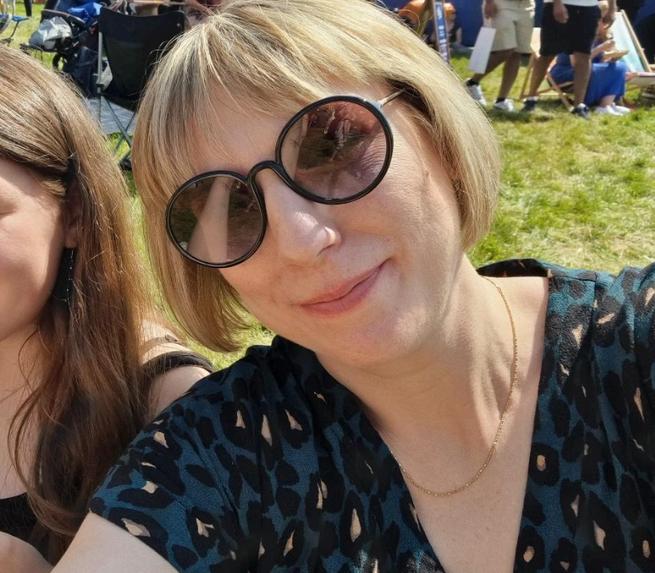
Liveryman; proposed by Sue Sumners
EMILY SUMNERS grew up in North London with parents Sue and David and younger brother Will. She graduated from City University with a BSc in Psychology, after which she embarked on a career in healthcare market research consultancy
Emily is now a director at Adelphi Research, where she is part of the leadership team and works with a range of pharmaceutical company clients, particularly in the oncology space She also heads up Adelphi Research’s consultative service delivery, with expertise in design thinking and behavioural science to support strategic decision-making.
Emily lives in Brockley, southeast London, with her 14-year-old daughter Roxy, who is currently choosing her GCSEs. Emily and Roxy are passionate about travelling and exploring new places, with Finland being their most recent highlight. She also loves food and is a keen cook, as well as enjoying eating out She is also a leisurely runner and enjoys yoga.
Emily is delighted to have joined the Needlemakers, and is very much looking forward to getting involved

Liveryman; proposed by Kimball Bailey
DR RICHARD YARWOOD trained as a pharmacist at the University of Nottingham and completed his practical training at The London Hospital in Whitechapel. He then moved into the industry sector, working for several pharmaceutical companies developing and manufacturing a wide range of products, including many needle injection presentations.
His many years playing football before the days of ‘protected goalkeepers’ led to several trips to the hospital, so Richard is no stranger to the sharp end of needles as well as the blunt end.
While working, he continued his education and obtained a PhD from Manchester and an MBA from Warwick Since retiring from executive duties, he has continued to provide consultancy services and serve on a few healthcare company boards. Besides his technical and personal experiences with needles, he enjoys good food, fine wine, and convivial company, which makes the Needlemakers an ideal Company to join and support.
Richard and his partner Sarah are based in Oxfordshire and travel extensively to catch up with friends and family across the globe

ADAM BUCKLAND is delighted to have been welcomed into the Needlemakers and looks forward to exploring the Company’s rich heritage while contributing to its vibrant community.
Originally from South Africa, Adam came to Oxford four years ago to study Public Policy and do an MBA.
He now lives in Clerkenwell and works as an economist in the industrials sector at KPMG, drawing on previous experience at McKinsey and the Bank of England to inform a global perspective on economic strategy and policy.
Away from the office, Adam nurtures a longstanding love for the arts, with a particular fondness for classical music performances
Equally at home in the city’s theatres, Adam relishes the excitement of a new play or a modern revival, finding both intellectual and creative stimulation in the diverse productions on offer
Adam also enjoys discovering London’s diverse culinary scene, sampling everything from modern fusion to classic British fare while sharing laughter with friends.
Enthusiastic about lifelong learning and building meaningful connections, Adam eagerly anticipates engaging with fellow Needlemakers and supporting the Company’s enduring traditions.

D h s e lives with her husband, Craig. She works for a clinical stage biotechnology company developing first-in-class treatments to target specific cancer types She holds a PhD and MPhil from the University of Cambridge, where her research focused on drug development for Alzheimer’s and Parkinson’s diseases.
Roxine is originally from South Africa and is passionate about educational outreach and development. She volunteers for the local alumni association of her alma mater, Stellenbosch, where she raises funds for scholarships given to women from her home province in South Africa who wish to study science, technology, engineering or maths.
The charitable aspect of the Needlemakers first drew Roxine to become more involved, and she has since thoroughly enjoyed the fellowship and spirit of the Company She is also immensely excited about the involvement of the Needlemakers in biotechnology and healthcare innovation, and hopes to contribute to this vision as a member of Cambridge’s extensive biomedical research community
In her spare time, Roxine can be found running and cycling around the fens with friends, trying her hand at film photography, or dissecting some fiction over a pint with her local book club

Woodwind Competition and Supper
Guildhall School of Music and Drama; 17.00–22.30
United Guilds Service and Lunch St. Paul’s, Pewterers’ Hall; 11.00–15.00
Webinar – Schools Online; 18 30–19 30
Court Lunch Trinity House; 12.30–14.45
Forge Mill Needle Museum Redditch; 9.45–15.00
Master’s Holiday Norwich
Election of Sheriffs and Lunch Guildhall; Armourers’ Hall; 11.00–15.00
Awards Dinner Apothecaries’ Hall; 18.30–10.30

Remember to view the latest updates in the Members’ area of the website for Livery and City Briefings and Court Meeting News. The Charitable Fund Accounts are also now available to view on the page of that name